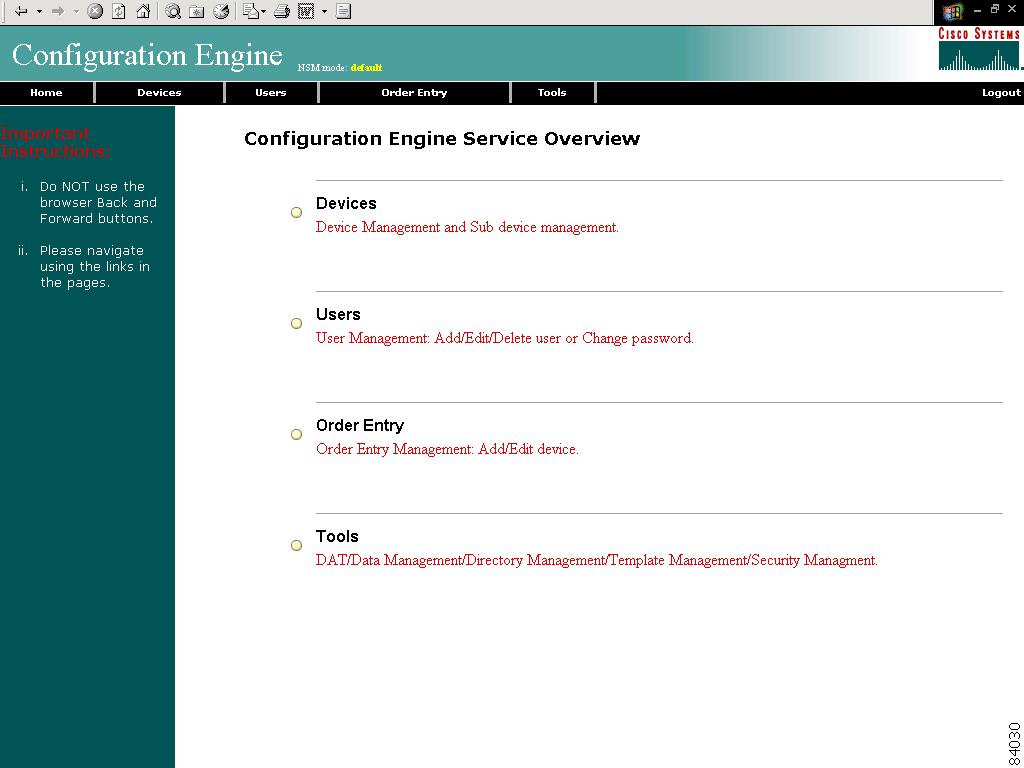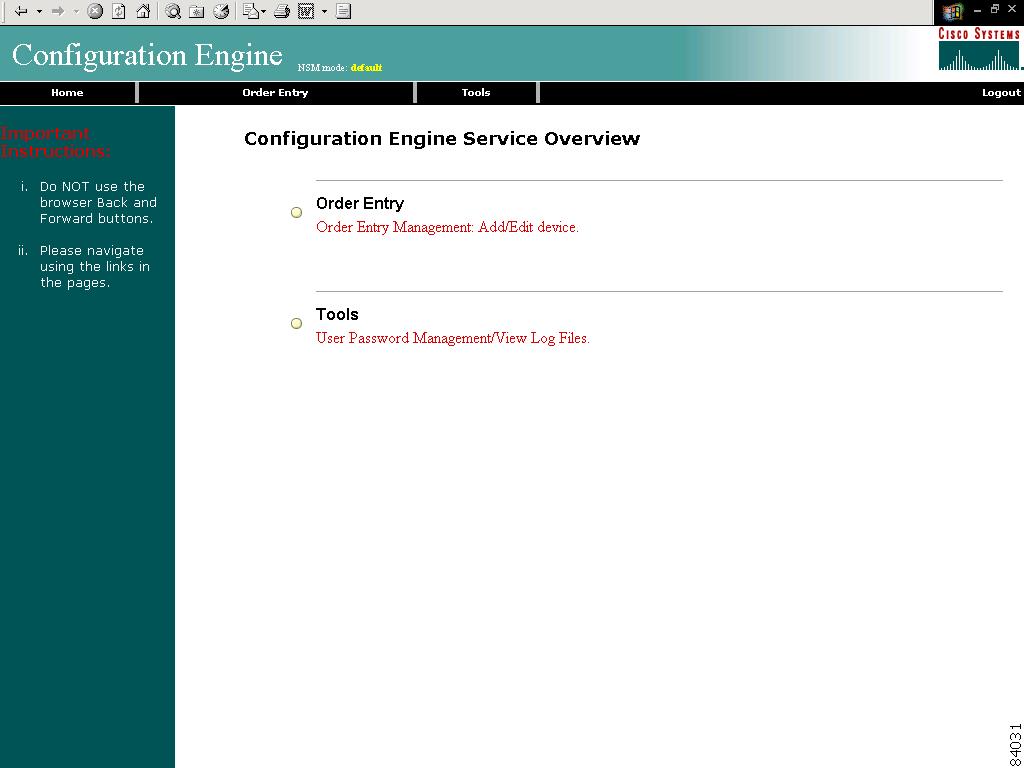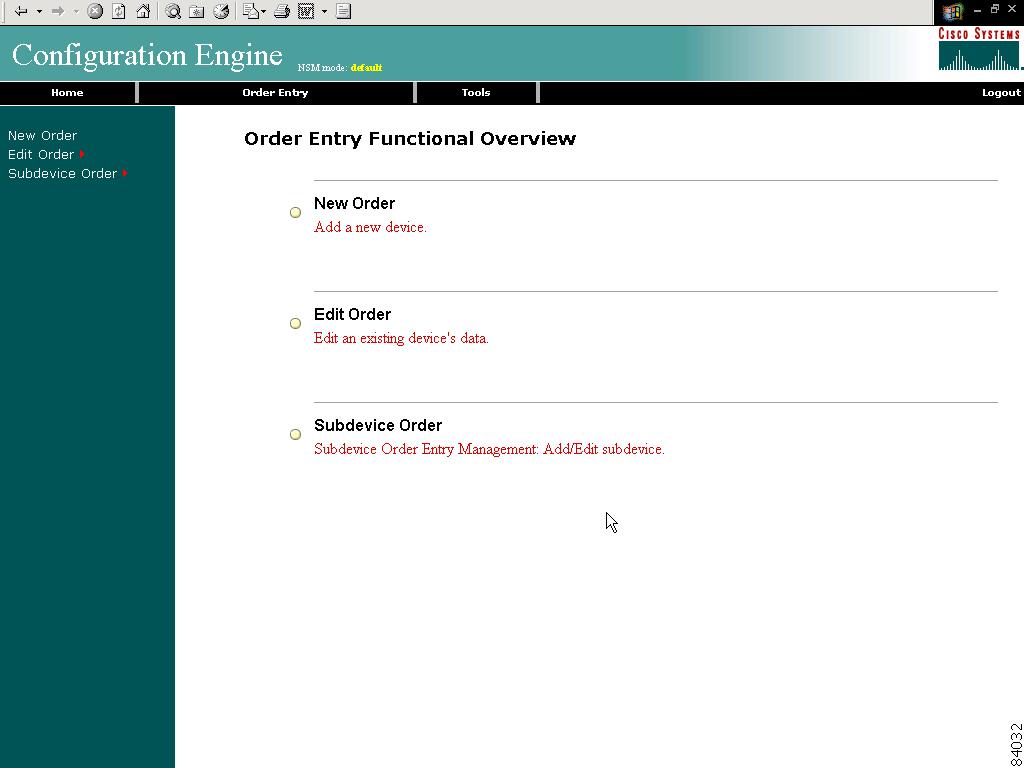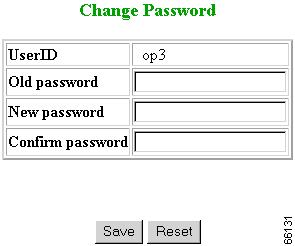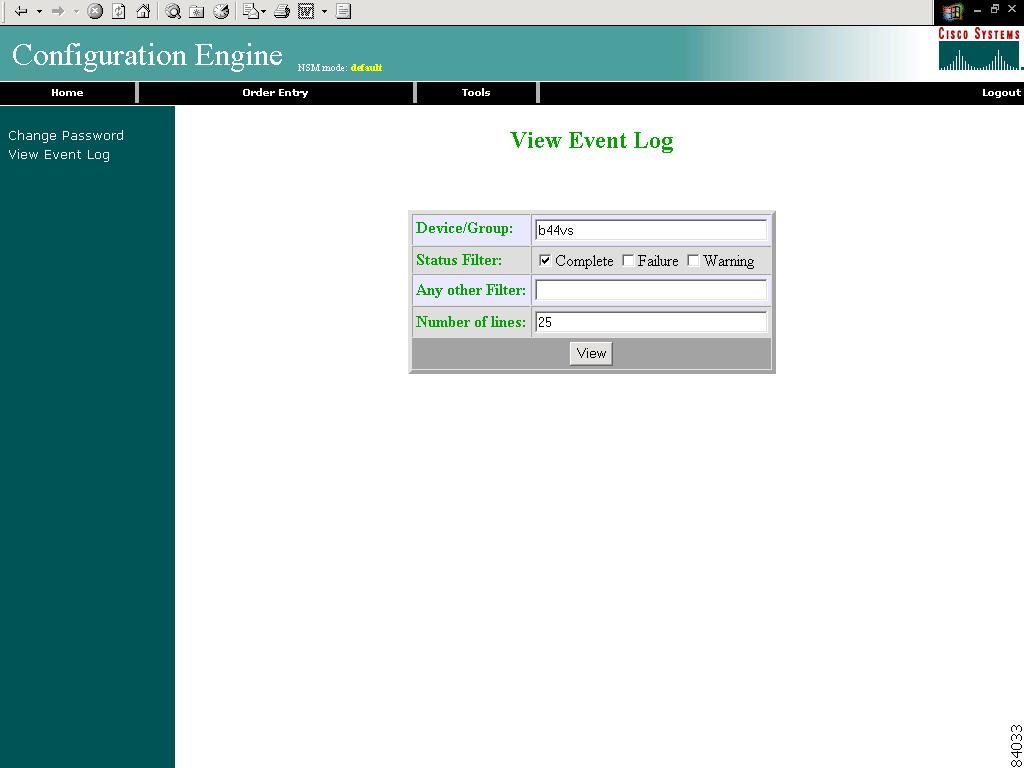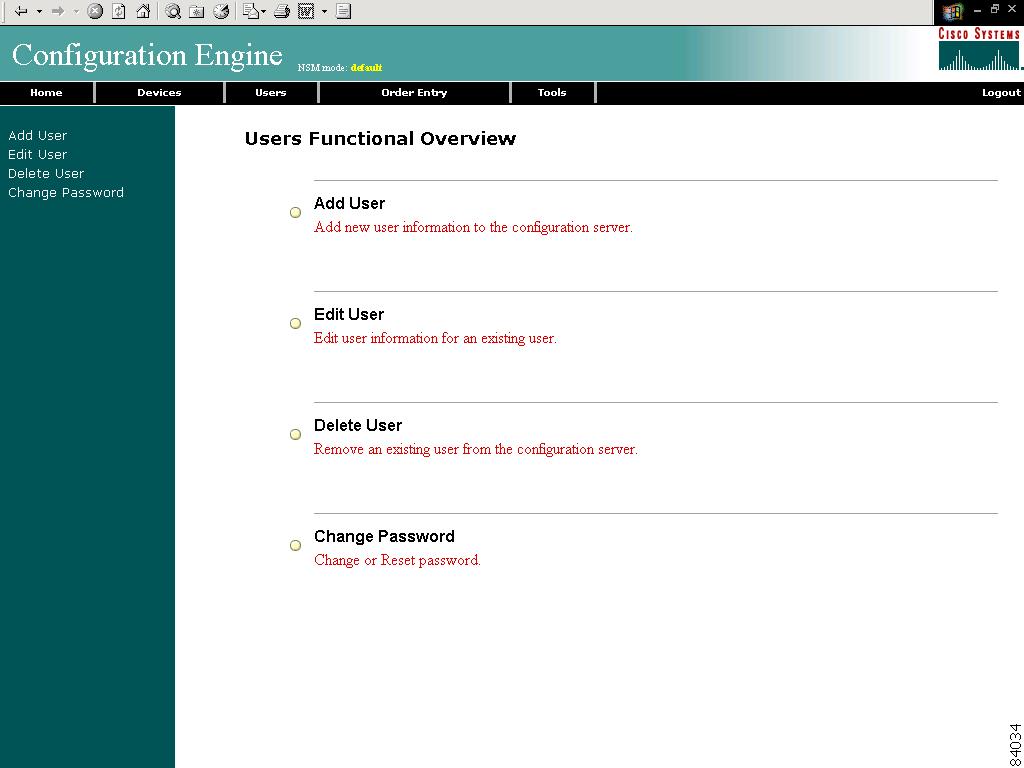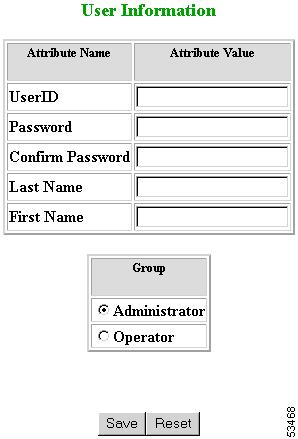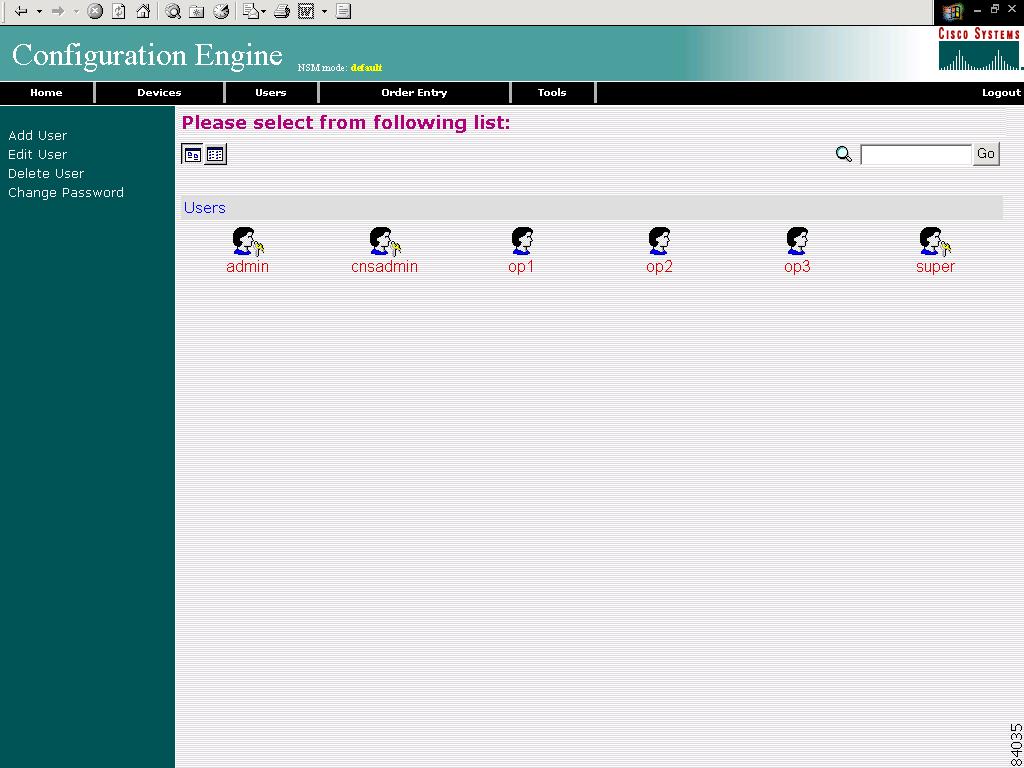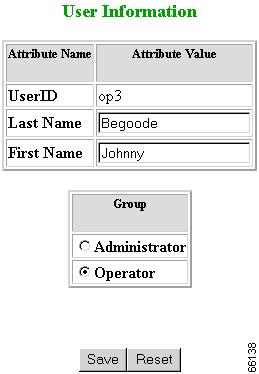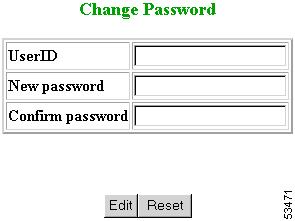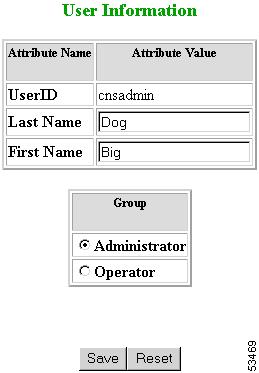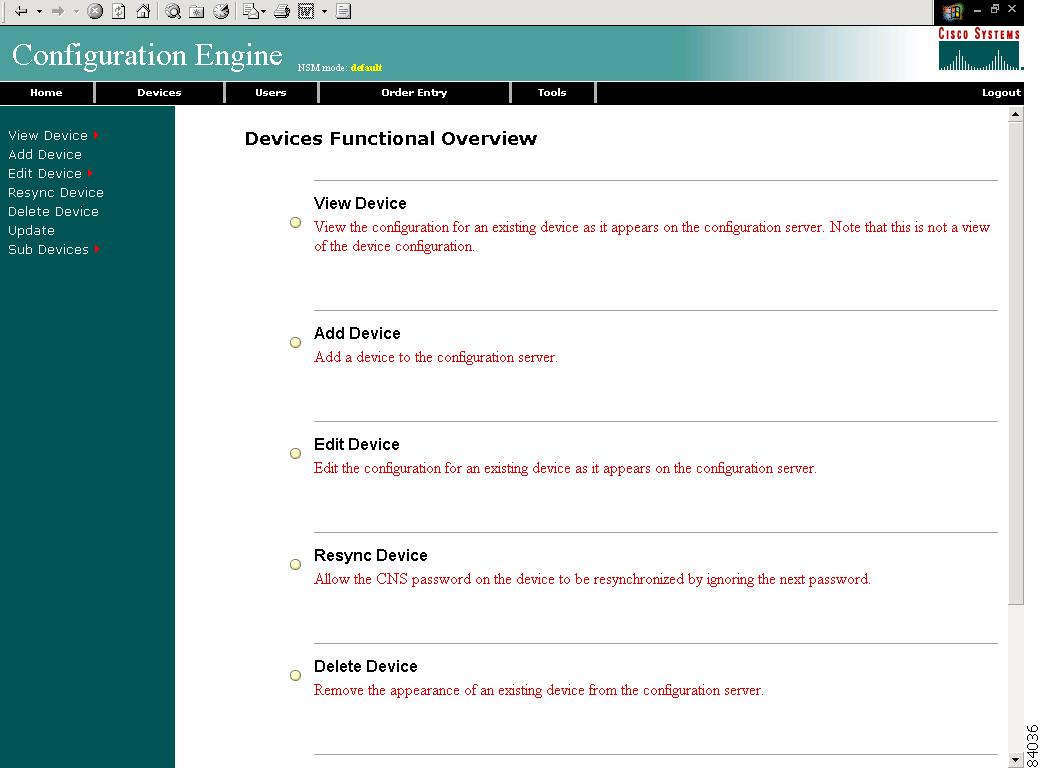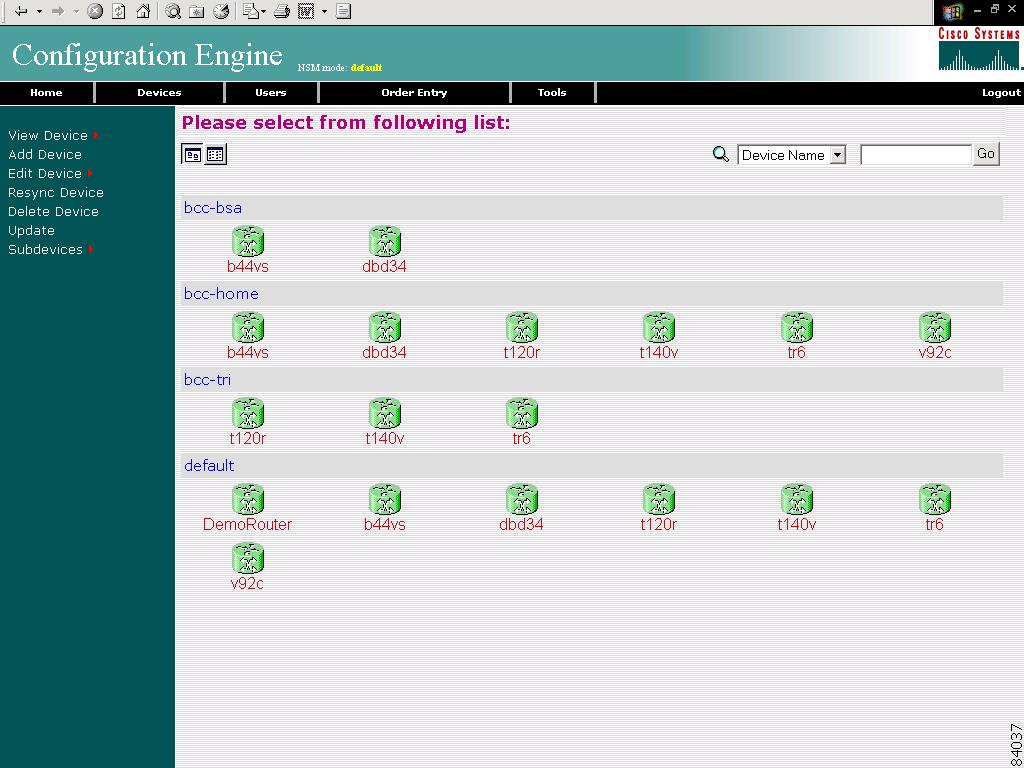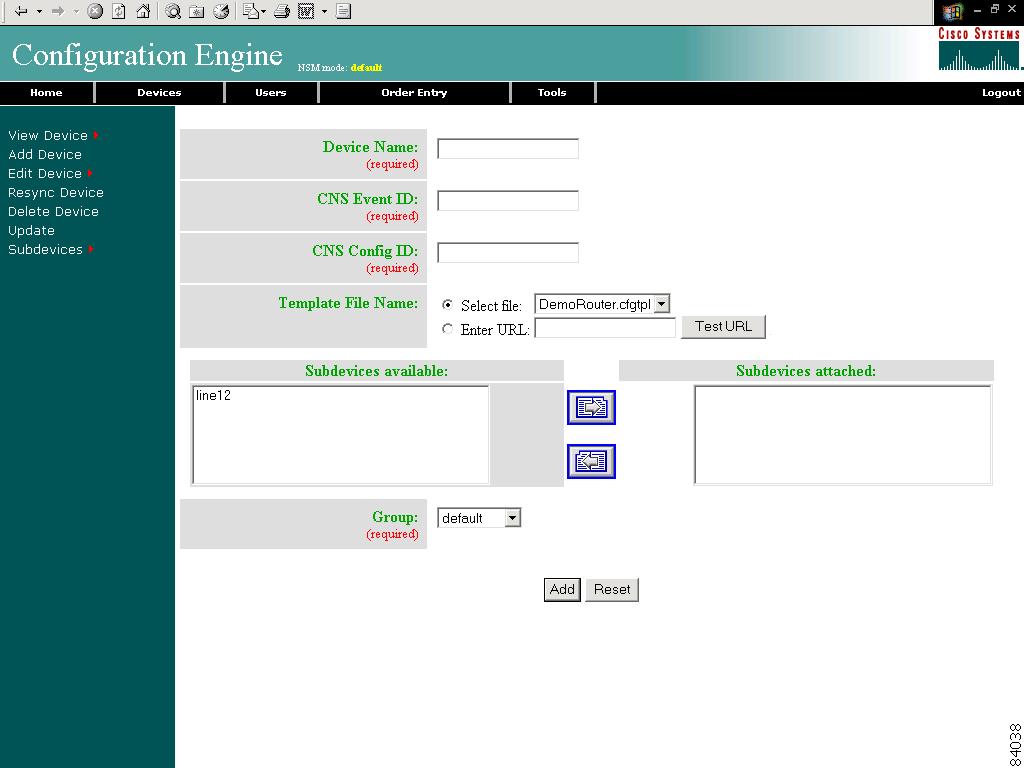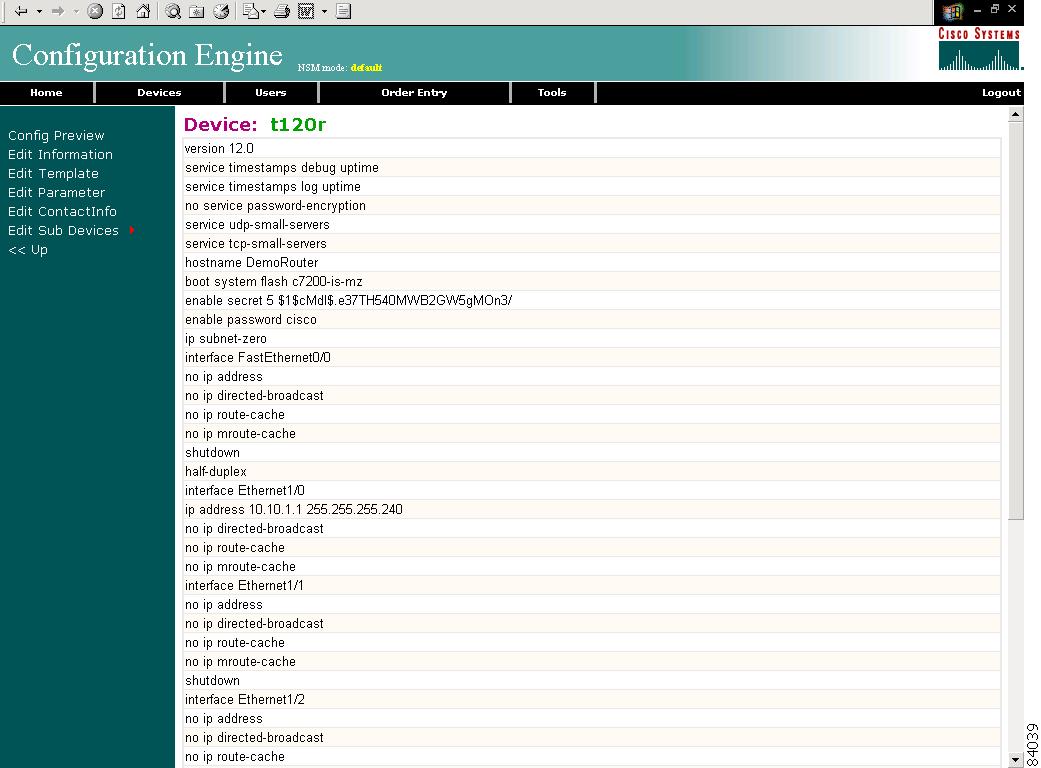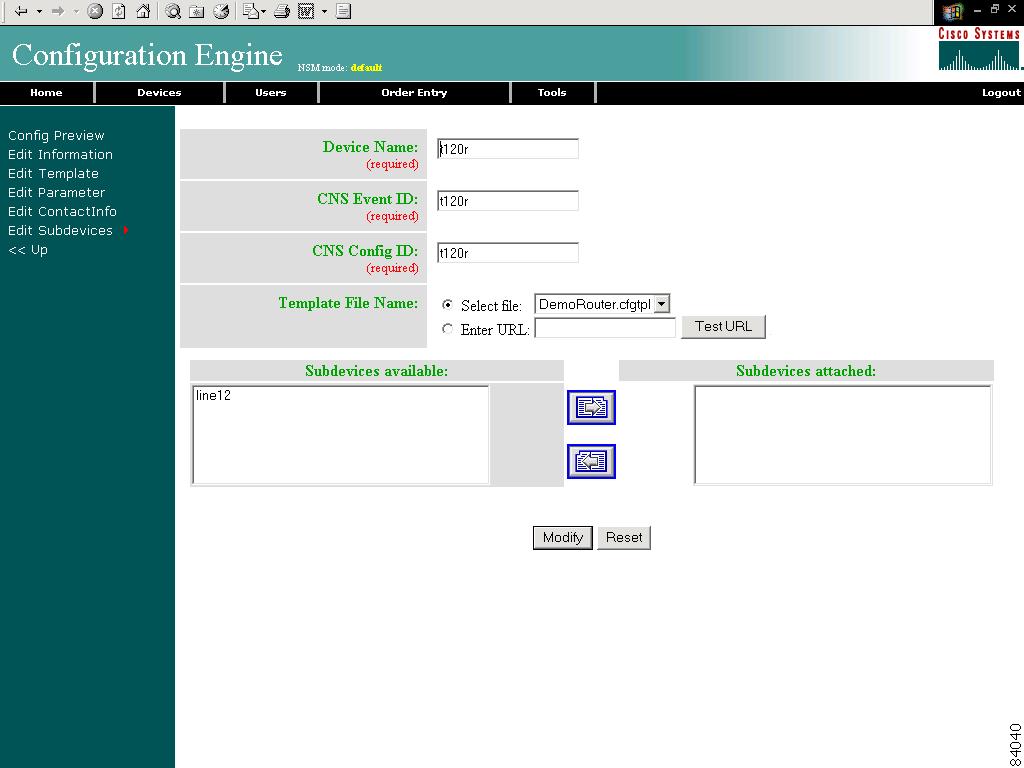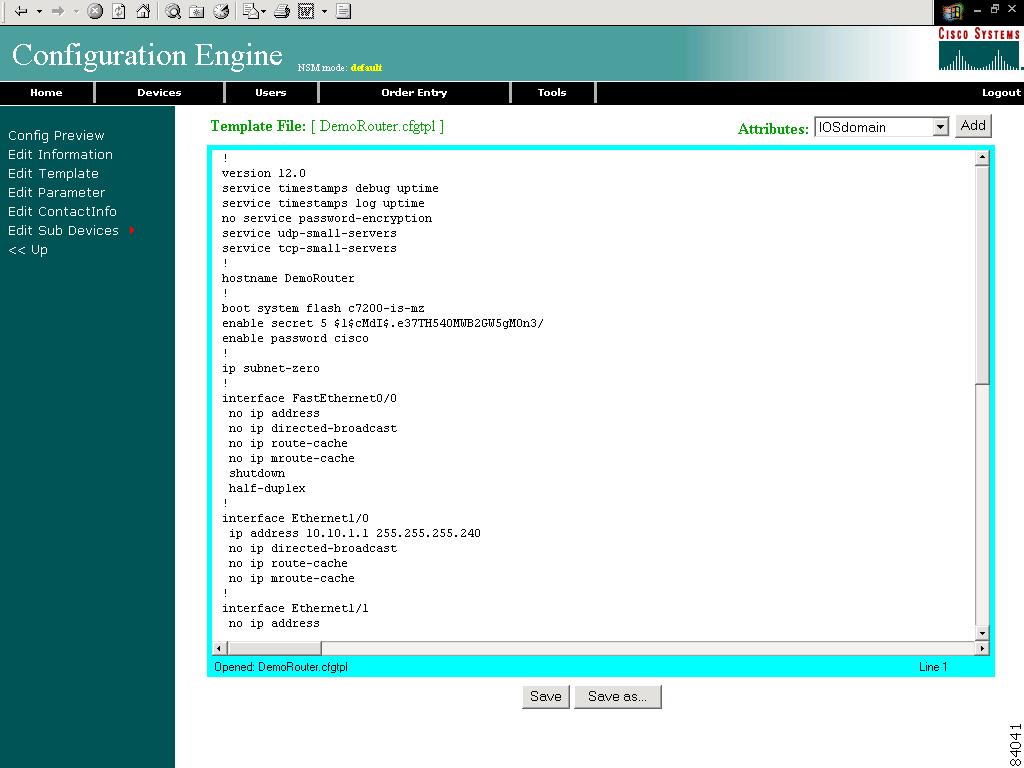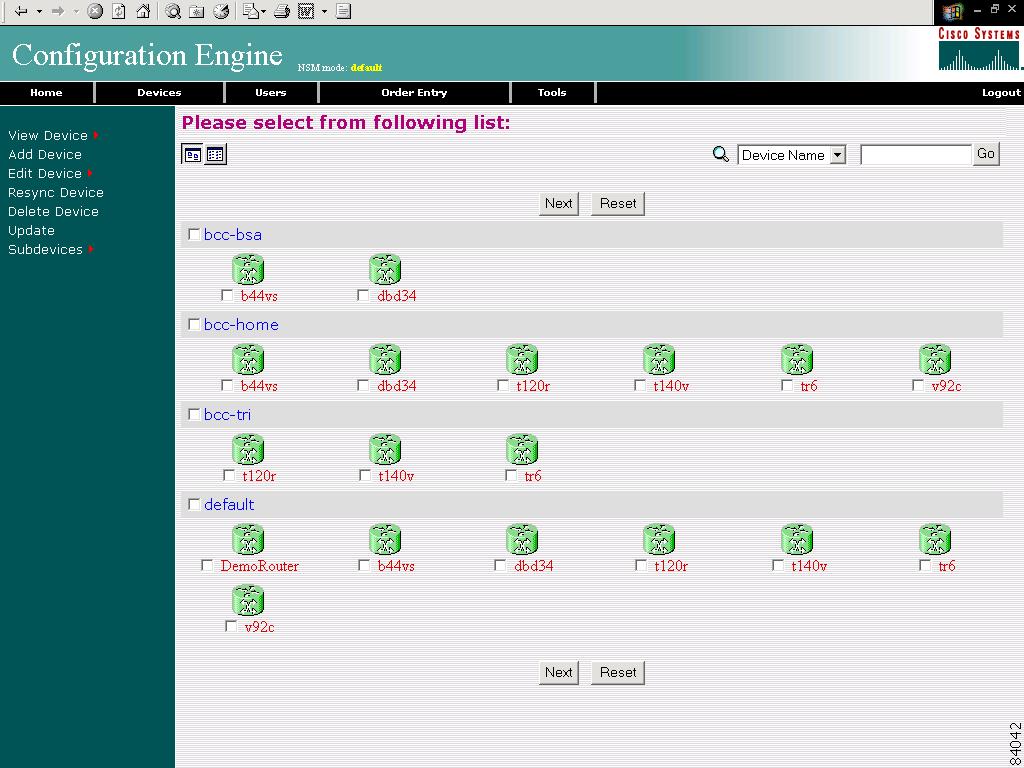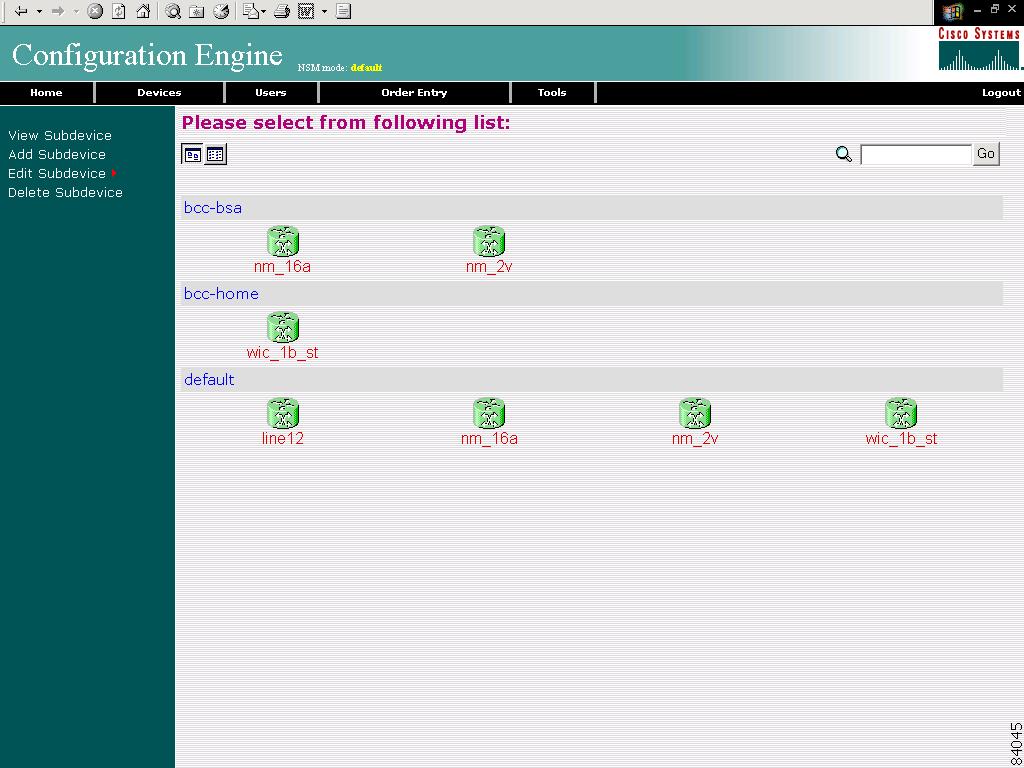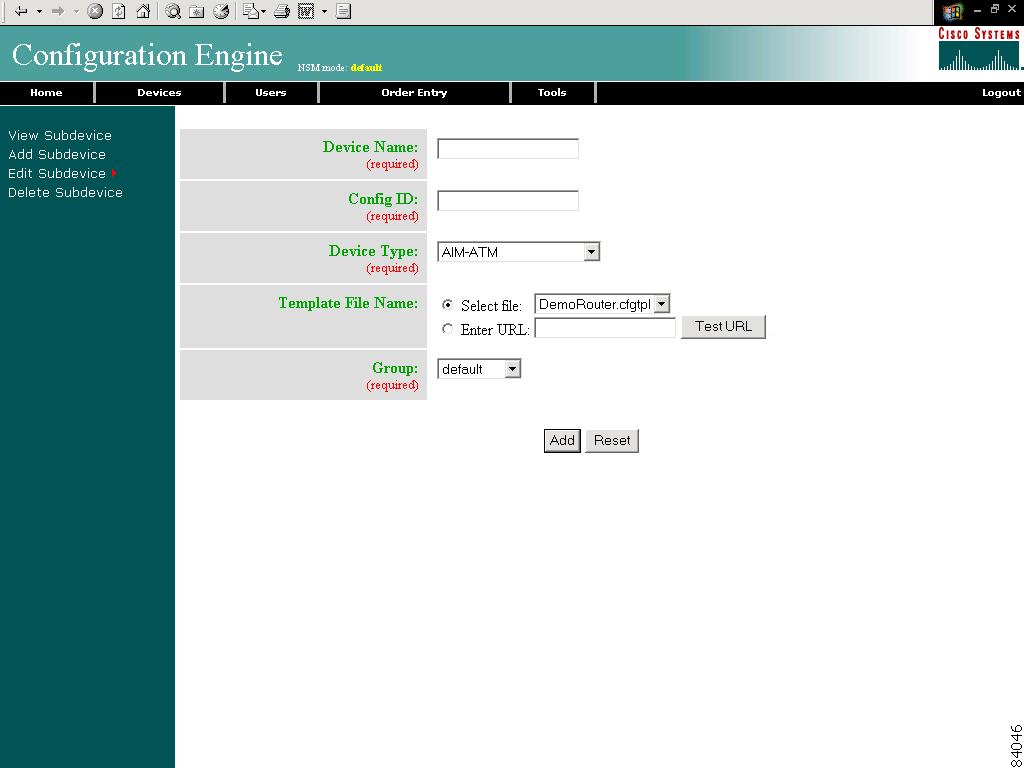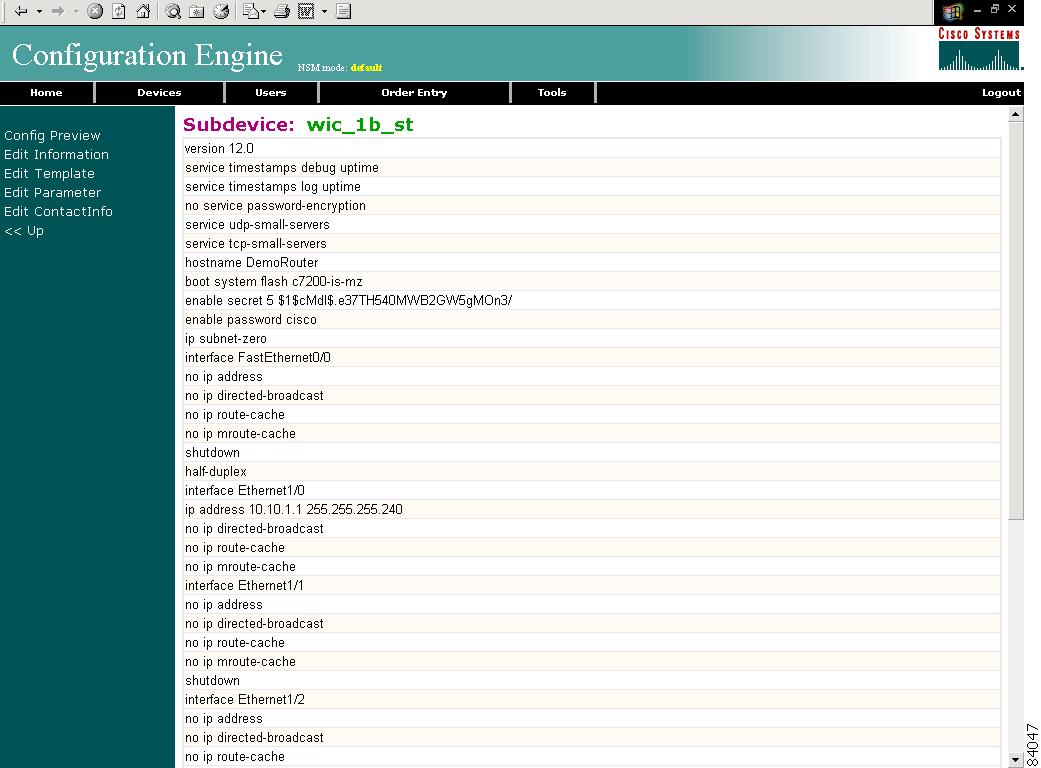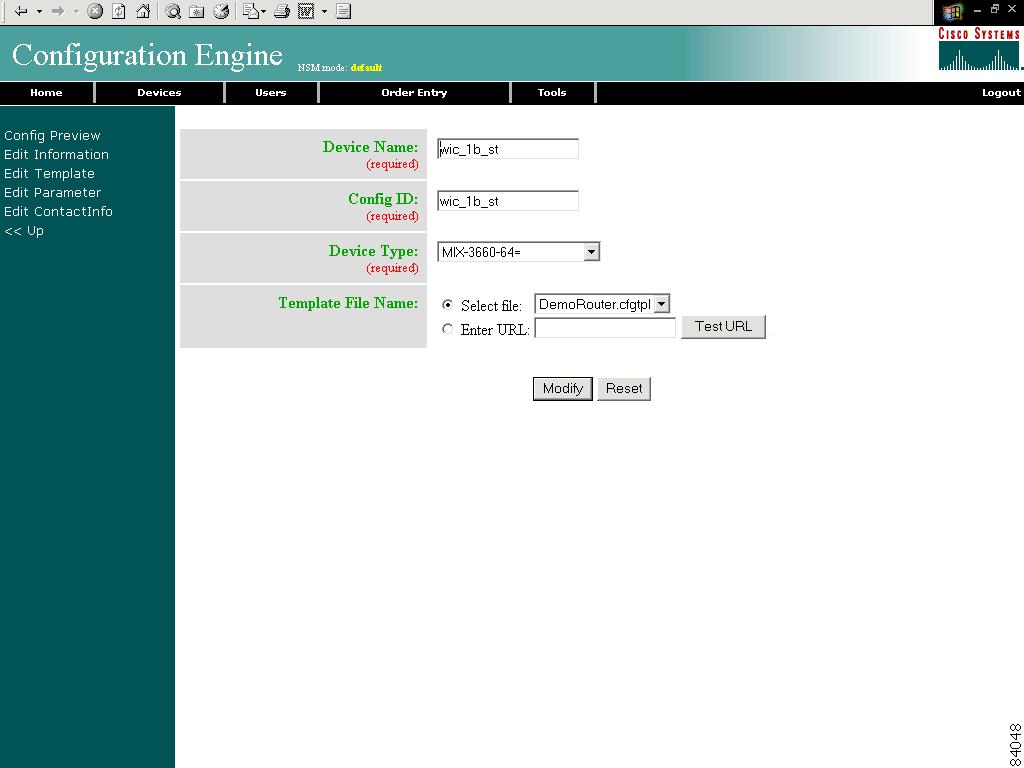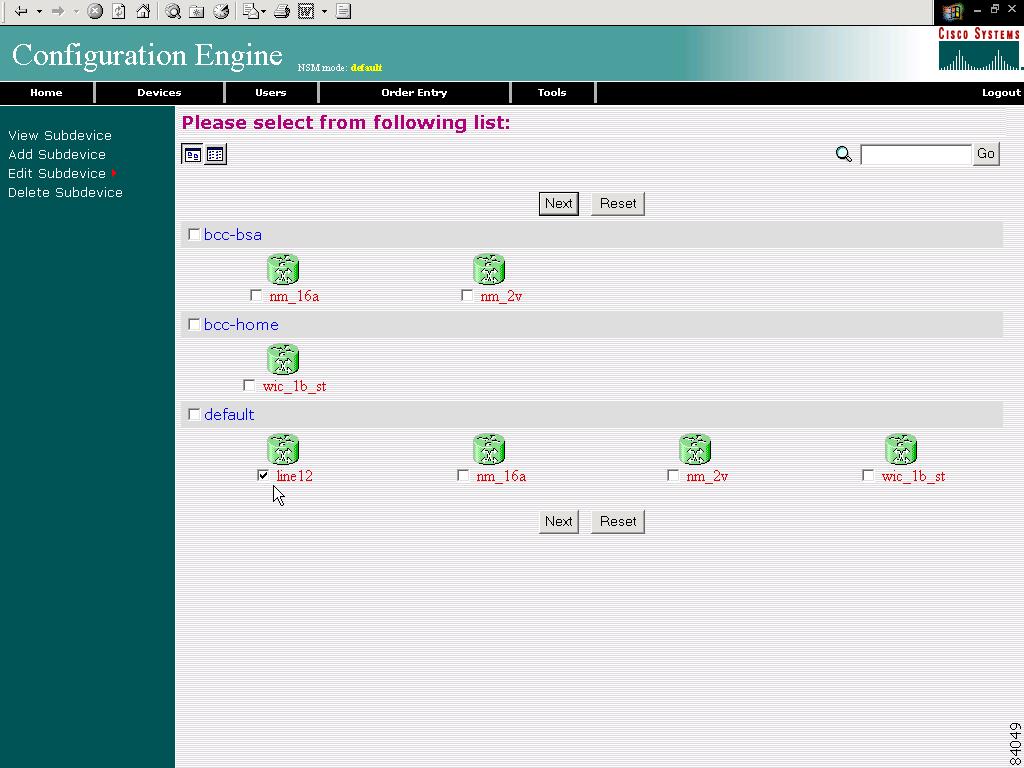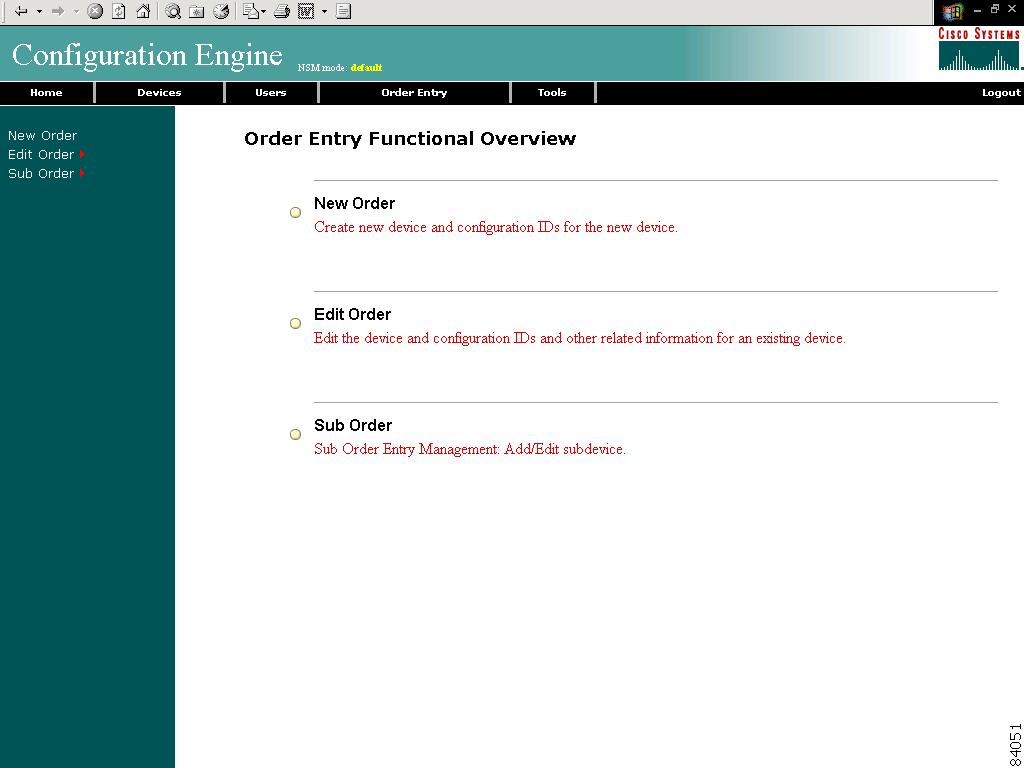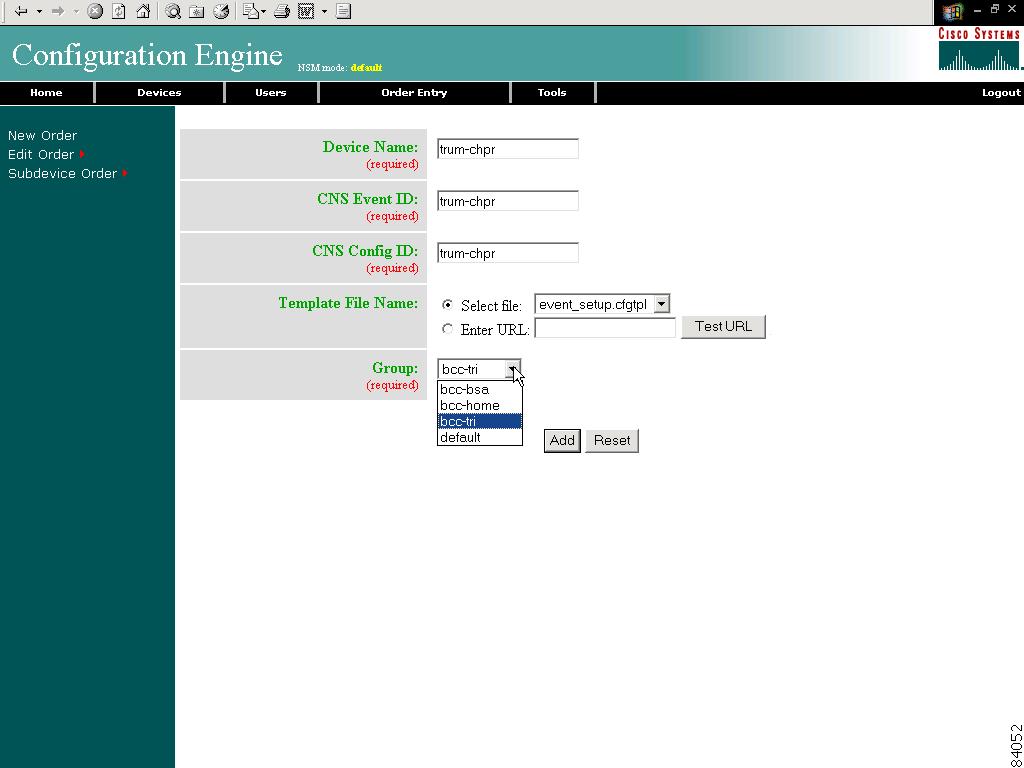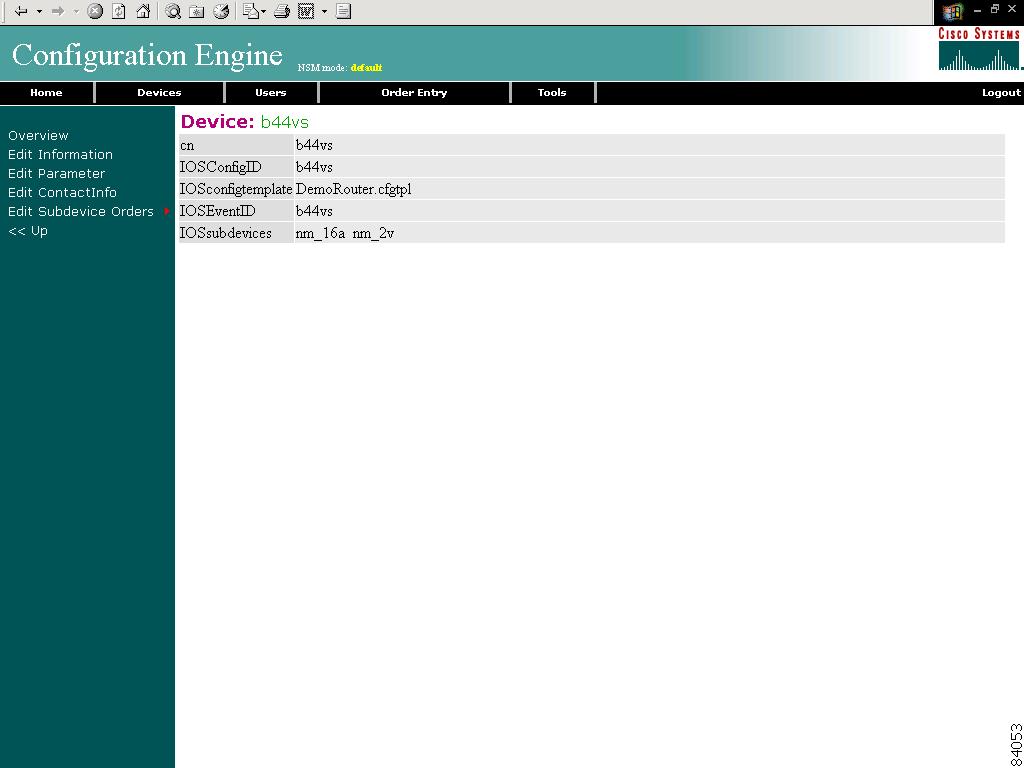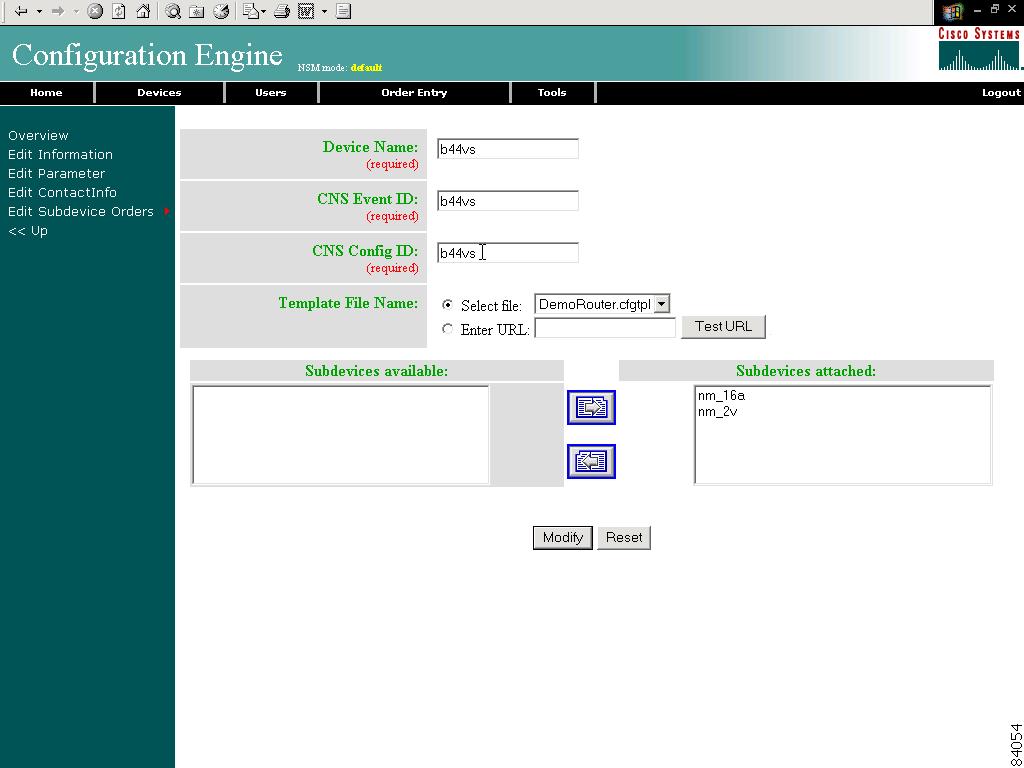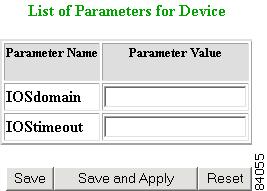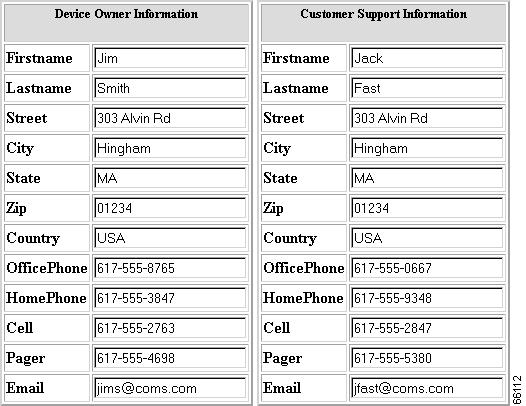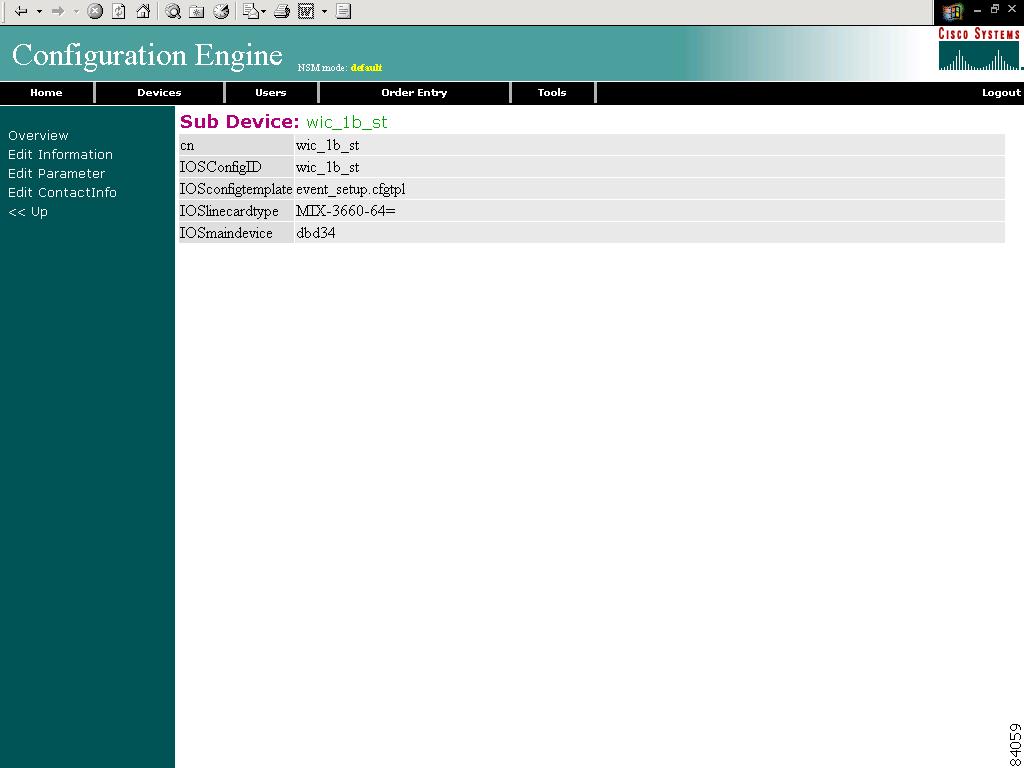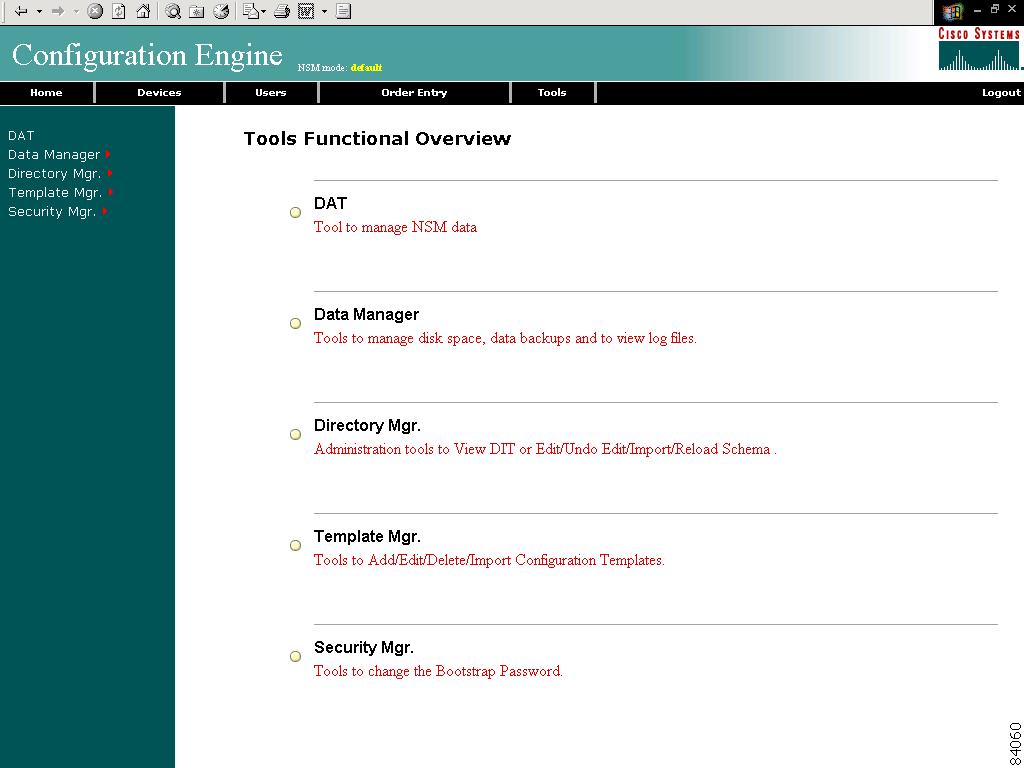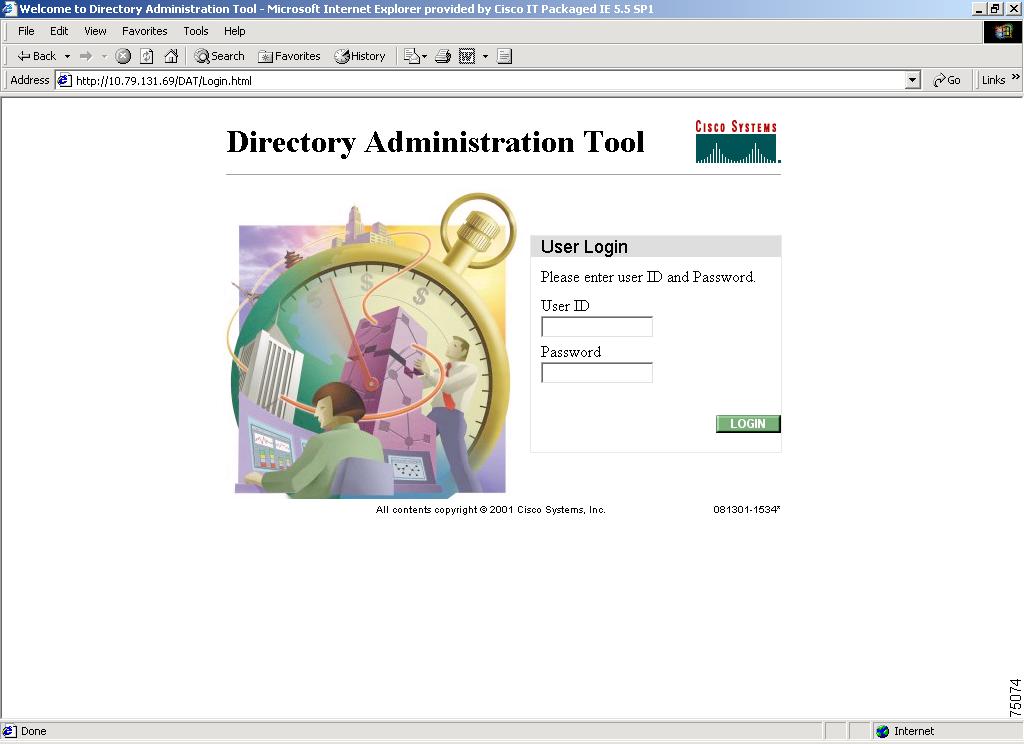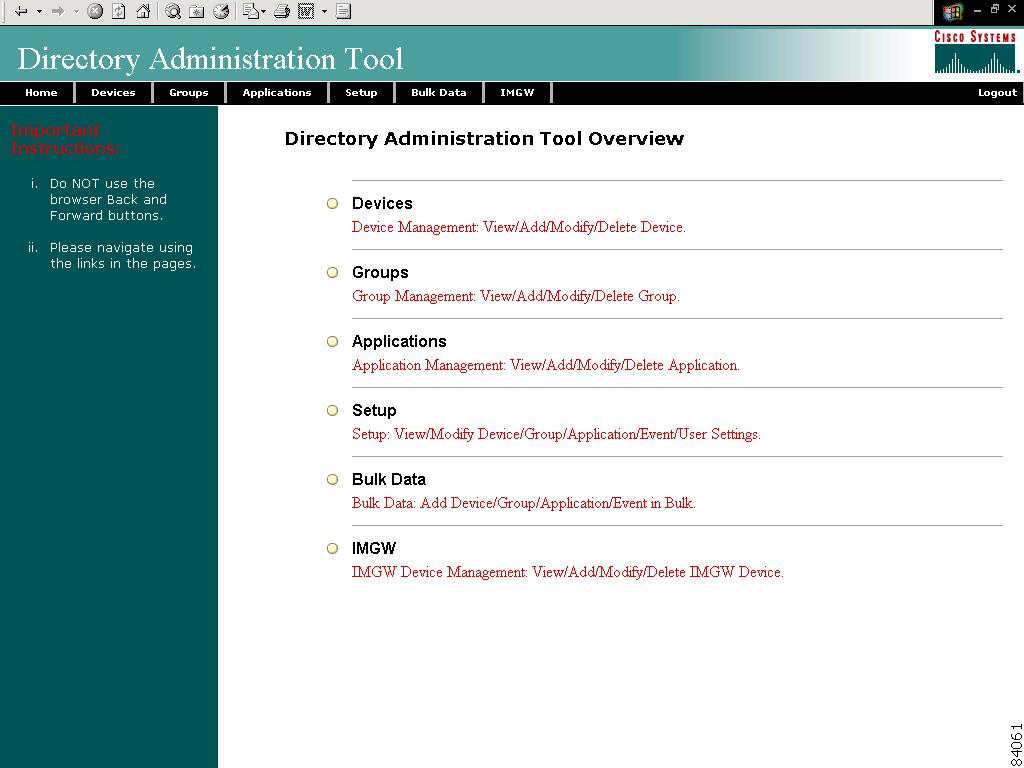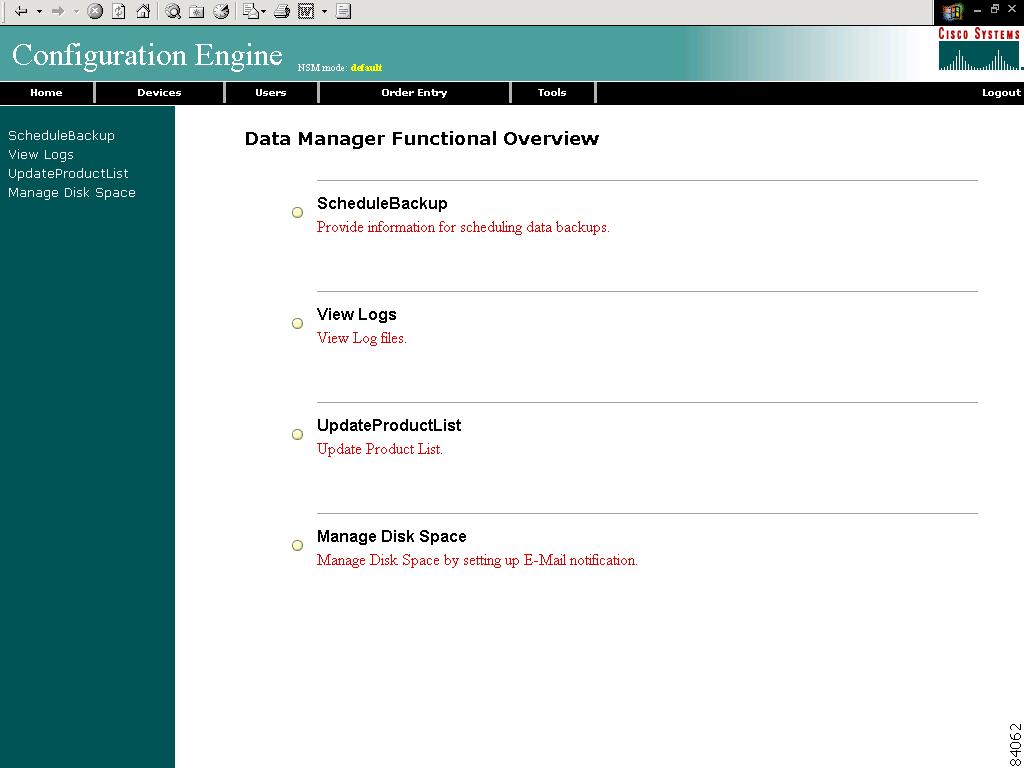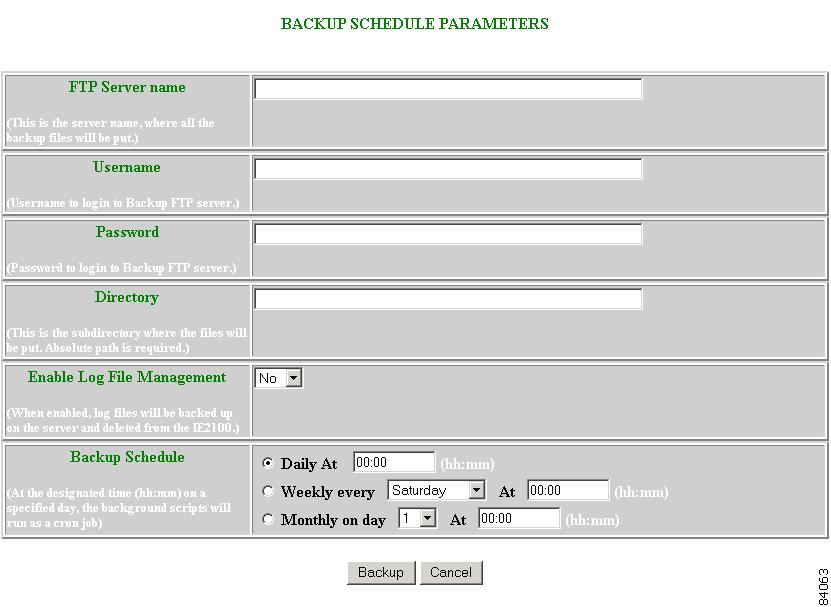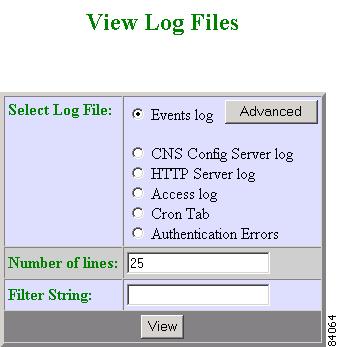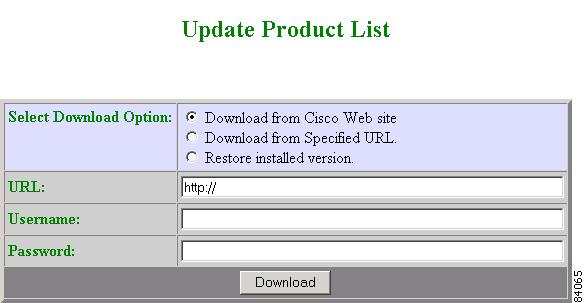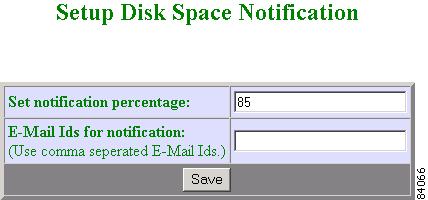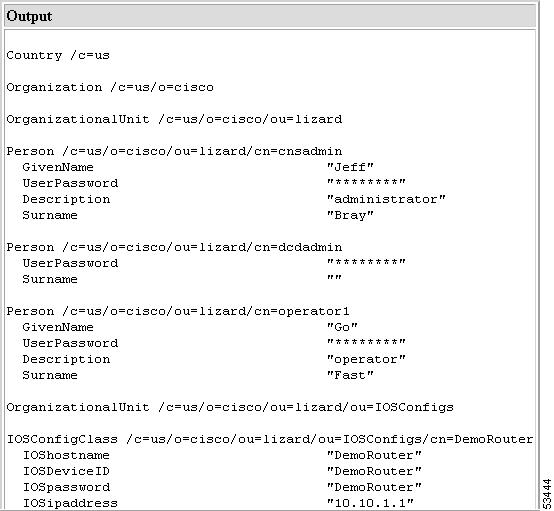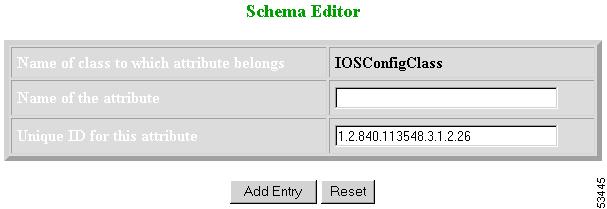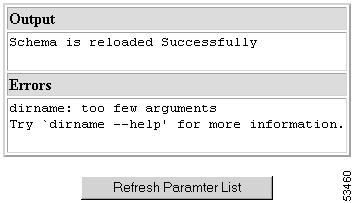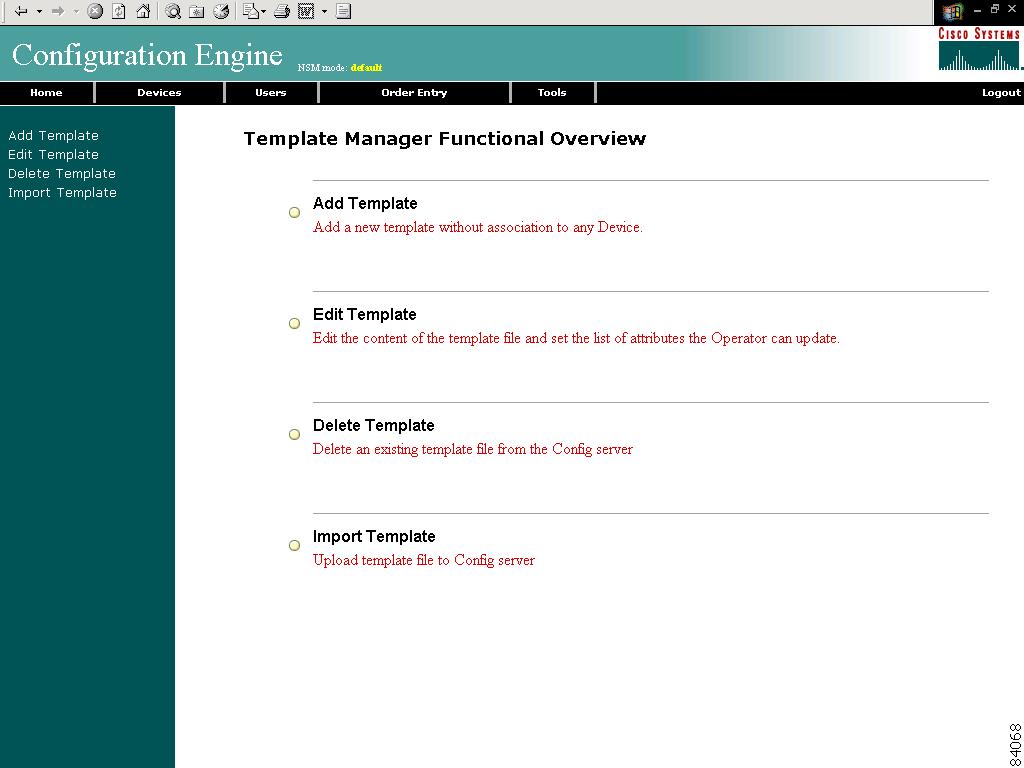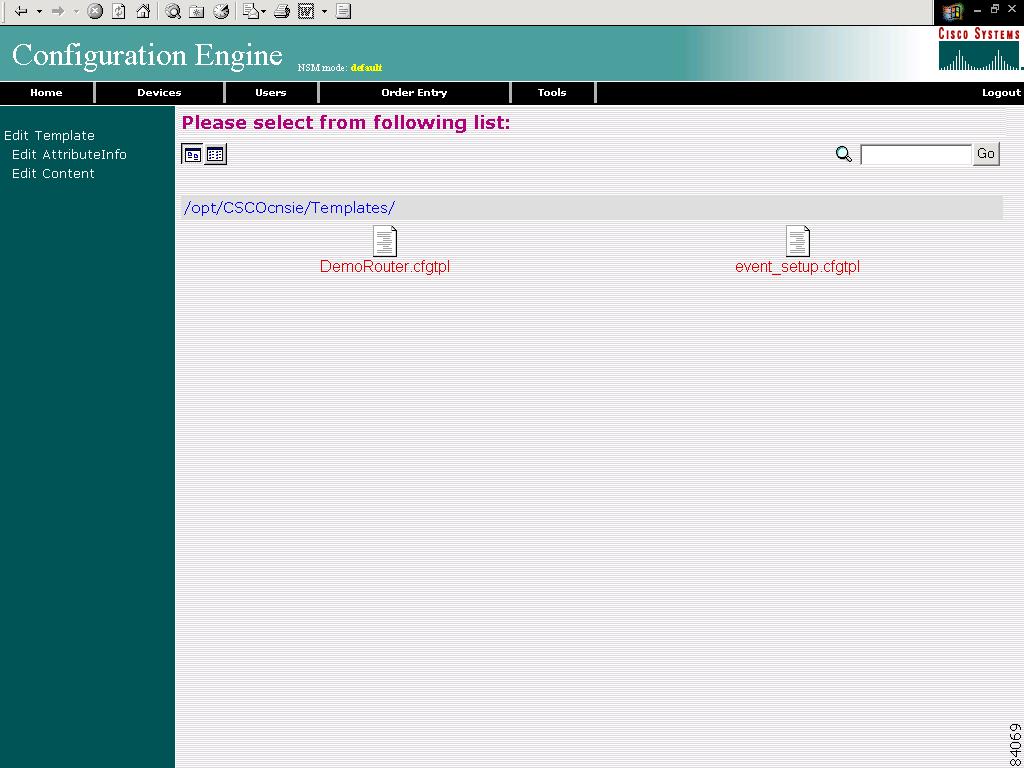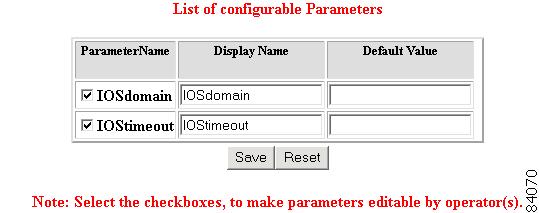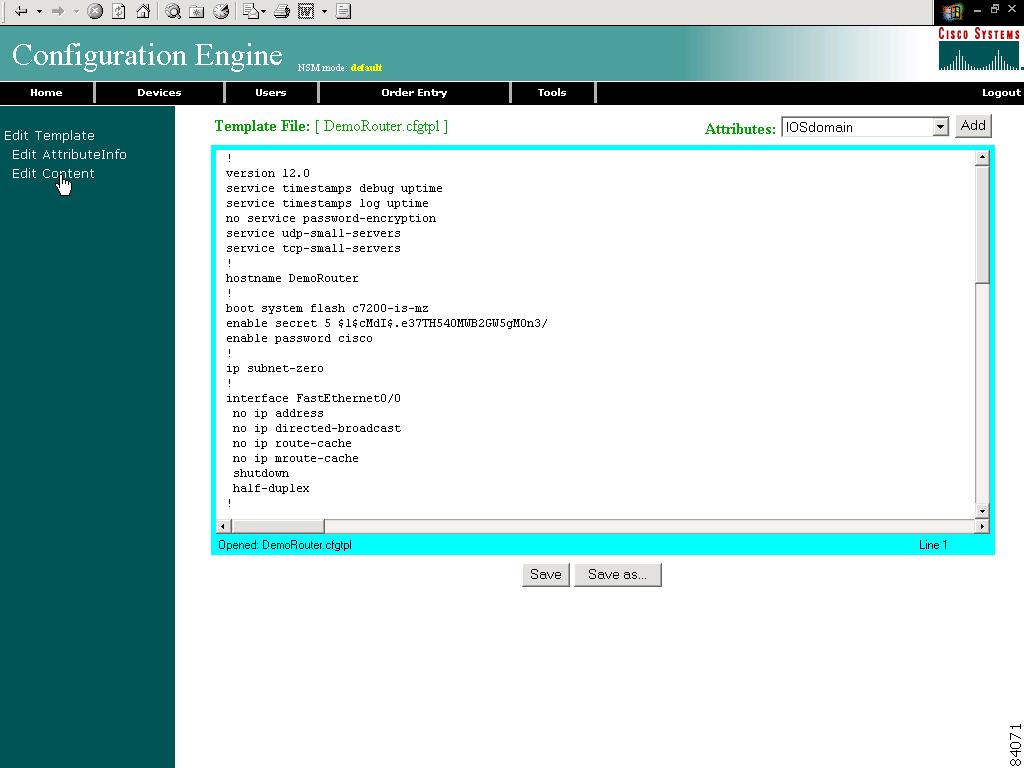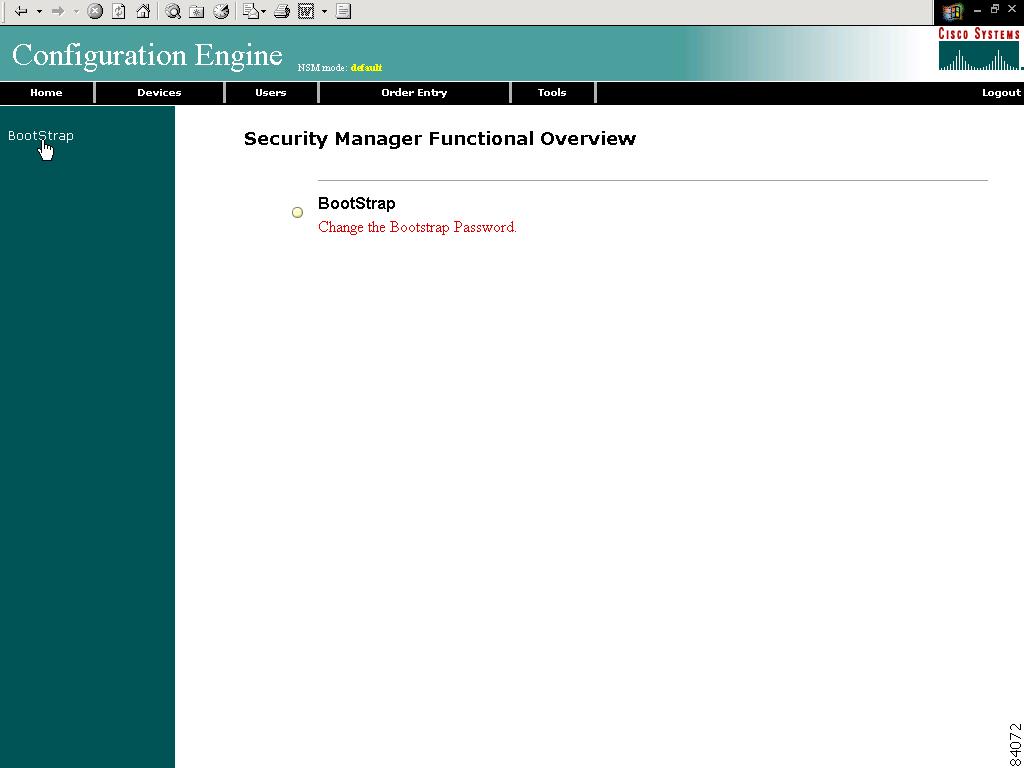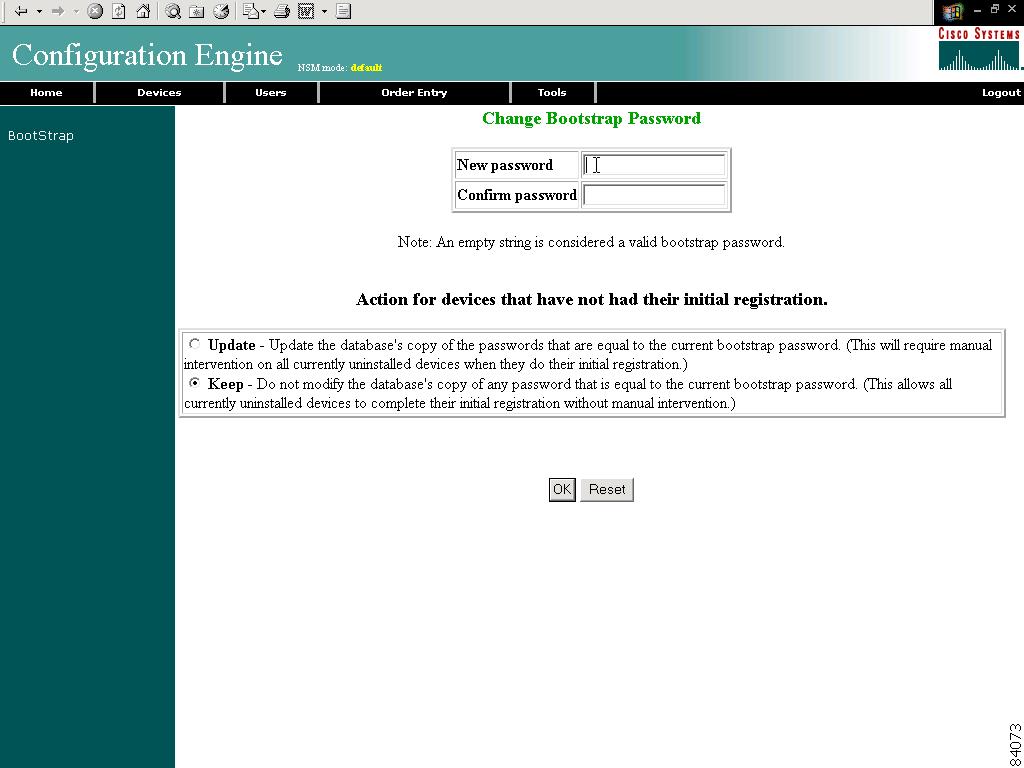

-
Cisco CNS Configuration Engine Administrator Guide, 1.3
-
Preface
-
Product Overview
-
Configuring the CNS 2100 Series System
-
Cisco CNS Configuration Engine Administration for Internal Directory Mode
-
Cisco CNS Configuration Engine Administration for External Directory Mode
-
Directory Administration Tool
-
Troubleshooting
-
Country Codes
-
Software Licenses and Acknowledgements
-
Index
-
Table Of Contents
Cisco CNS Configuration Engine Administration for Internal Directory Mode
How to Log In and Out of the System
Device Configuration Order Entry
How to Change or Reset a Password at the Operator Level
Administrator-Level Operations
How to Change or Reset a User Password
How to Change Account Privilege Level
How to View Device Configuration
How to Re-synchronize a Device
How to Update a Device Configuration
Device Configuration Order Entry
How to Enter an Order for a New Device Configuration
Editing an Existing Configuration Order
Managing Subdevice Configuration Orders
How to Manage Directory Content
How to View the Directory Information Tree
Templates and Template Management
Sample Templates for Modular Router
How to Change Bootstrap Password
How to Restore the CNS Directory
Cisco CNS Configuration Engine Administration for Internal Directory Mode
This chapter describes the Cisco CNS Configuration Engine administration tasks for Internal Directory mode including information about:
•
How to Log In and Out of the System
•
Device Configuration Order Entry
Levels of Access
In Internal Directory mode, there are two categories of users who have access to device information:
•
Administrator
•
Operator
An Administrator has the higher access level of the two categories; full access to device and user information. An Operator has access to only order entry and operator password-related tasks.
For example, an Administrator can access all the functional areas of the user interface. Whereas, an Operator only has access to Order Entry and Tools functions.
How to Log In and Out of the System
You can connect to the system by means of:
•
Telnet
•
System console
How to Log In
To log into the system, follow these steps:
Step 1
Launch your web browser.
This user interface is best viewed using Microsoft Internet Explorer, version 5.5 or later.
Step 2
Go to the Cisco CNS Configuration Engine URL.
For example: http://<ip_address>/config/login.html
Note
If encryption is set during Setup (see "Encryption Settings" section), use https://<ip_address>/config/login.html.
The login window appears (see Figure 3-1).
Figure 3-1 Logging In to the Configuration Server
Step 3
Enter your User ID.
This is the value for the ConfigService AdminID parameter that you entered during Setup.
Step 4
Enter your password.
Step 5
Click LOGIN.
For an Administrator, the full-function Cisco CNS Configuration Engine Home page appears (see Figure 3-2).
For an Operator, a limited-function Cisco CNS Configuration Engine Home page appears where the active tabs are Home, Order Entry, and Tools (see Figure 3-3).
Figure 3-2 Administrator Home Page
Figure 3-3 Operator Home Page
How to Log Out
To log out of the system, click the Logout button.
Operator-Level Operations
After logging into the Cisco CNS Configuration Engine, an Operator has access to the following functions:
•
Order Entry
–
New Order
–
Edit Order
–
Subdevice Order
•
Tools
–
Change Password
–
View Event Log
The order entry functions of creating a new device configuration order, editing an existing order, and managing subdevice orders are available to both Administrator and Operator.
Under tools, an Operator has access to the password editor (for changing or resetting only their own password), and the event log.
Device Configuration Order Entry
To conduct device configuration order entry operations as an Operator, follow these steps:
Step 1
From the Home page, click Order Entry.
The Order Entry page appears (see Figure 3-4).
Step 2
To add and edit device configuration orders, see "Device Configuration Order Entry" section.
Figure 3-4 Order Entry for Operator-Level User
How to Change or Reset a Password at the Operator Level
To change or reset a password at the operator level, follow these steps:
Step 1
From the Home page, click Tools.
The password editor appears (see Figure 3-5).
Figure 3-5 Operator Password Editor
Step 2
Enter your old password.
Step 3
Enter your new password, then repeat.
Step 4
To clear your entries, click Reset.
Step 5
To save your edits, click Edit.
Step 6
To return to the main menu, click on the Tools tab.
How to View the Event Log
As an operator, to view the Event Log, follow these steps:
Step 1
From the Home page, click Tools.
Step 2
To view the Event Log, click View Event Log.
The Event Log control panel appears (see Figure 3-6)
Figure 3-6 Operator-Level Event Log Control Panel
Administrator-Level Operations
In Internal Directory mode, an Administrator can access all of the functions provided by the Cisco CNS Configuration Engine user interface including managing user accounts and devices.
How to Manage User Accounts
To begin managing user accounts, follow these steps:
Step 1
Log into the system (see "How to Log In and Out of the System" section).
Step 2
From the Home page, click on the Users tab.
A functional overview of the user administration options appears (see Figure 3-7).
Figure 3-7 User Administration Overview
How to Add a User Account
To add a user account, follow these steps:
Step 1
From the User Administration page, click Add User.
The User Information dialog box appears (see Figure 3-8).
Figure 3-8 User Information
Step 2
Enter a valid value (no spaces) in the UserID field.
Step 3
Enter a password in the Password field.
Step 4
Confirm the password by entering it again in the Confirm Password field.
Step 5
Enter the user's last name in the Last Name field.
Step 6
Enter the user's first name in the First Name field.
Step 7
In the Group pane, click the radio button that classifies the privilege level (Administrator, Operator) of this user.
Step 8
To clear your entries, click Reset.
Step 9
To save your entries, click Save.
Step 10
To return to the main menu, click on the User tab.
How to Edit a User Account
To edit a user account, follow these steps:
Step 1
From the User Administration page, click Edit User.
A list of users appears (see Figure 3-9).
Figure 3-9 User List
Step 2
From the User List, click on the icon for the user account you wish to edit.
Note
Administrator-level users are shown with a key icon associated with the figure icon.
The User Information page appears (see Figure 3-10).
Figure 3-10 User Information
Step 3
To modify the user ID, enter a valid value (no spaces) in the UserID field.
Step 4
To modify the user's last name, edit the Last Name field.
Step 5
To modify the user's first name, edit the First Name field.
Step 6
To modify the user group status, click the appropriate radio button in the Group pane.
Step 7
To clear your entries, click Reset.
Step 8
To save your entries, click Save.
User information update status appears (see Figure 3-11).
Step 9
To return to the main menu, click on the User tab.
Figure 3-11 User Information Update Status
How to Delete a User Account
To delete a user account, follow these steps:
Step 1
From the User Administration page, click Delete User.
Step 2
From the user list (see Figure 3-9), click on the icon for the user account you wish to delete.
Step 3
To return to the main menu, click on the User tab.
How to Change or Reset a User Password
To change or reset a user password, follow these steps:
Step 1
From the User Administration page, click Change Password.
The Change Password dialog box (see Figure 3-12) appears.
Figure 3-12 Change Password
Step 2
Enter the UserID for the user account password you want to change or reset.
Step 3
Enter the new password in the New password field.
Step 4
Enter the new password again in the Confirm password field.
Step 5
To clear your entries, click Reset.
Step 6
To save the new password, click Edit.
Step 7
To return to the main menu, click on the Users tab.
How to Change Account Privilege Level
To change the privilege level of a user account, follow these steps:
Step 1
From the User Administration page, click Edit User.
Step 2
Choose the user in question from the user list (see Figure 3-9).
The User Information page appears (see Figure 3-13).
Figure 3-13 User Information
Step 3
In the Group pane, click the radio button that classifies the privilege level (Administrator, Operator) of this user.
Step 4
To clear your entries, click Reset.
Step 5
To save your entries, click Save.
Step 6
To return to the main menu, click on the User tab.
How to Manage Devices
To begin managing devices, follow these steps:
Step 1
Log into the system (see "How to Log In and Out of the System" section).
Step 2
From the Home page, click on the Devices tab.
A functional overview of the device administration options appears (see Figure 3-14).
Figure 3-14 Device Administration Overview
How to View Device Configuration
To view a device configuration, follow these steps:
Step 1
From the Devices Functional Overview page, click View Device.
The Device List page appears (see Figure 3-15).
Figure 3-15 Device List
Step 2
Click on the icon for the device configuration you wish to view.
The Configuration for that device appears.
Note
The device configuration displayed is the configuration as it appears at the configuration server. It may not be the configuration running on the device.
Step 3
To return to the main menu, click on the Devices tab.
How to Add a Device
To add the logical appearance of a device to the configuration server, follow these steps:
Step 1
From the Devices Functional Overview page, click Add Device.
The Device Information page appears (see Figure 3-16).
Figure 3-16 Device Information Page
Step 2
Enter a valid value (no spaces) in the Device Name field.
Step 3
Accept the default value that appears or enter another valid value (no spaces) in the Event ID field.
Step 4
Accept the default value that appears or enter another valid value (no spaces) in the Config ID field.
The ConfigID must match the one used to manage this particular device.
Step 5
Choose a template file.
To use a template on your Cisco CNS Configuration Engine:
a.
Choose Select file.
b.
Use the pull-down menu to choose a template.
OR
To use an external template:
a.
Choose Enter URL.
b.
Enter the full URL for the server, directory, and filename where the template is stored. Currently, only http is supported.
c.
To test access to the external template, click Test URL.
If the server is unavailable or the external template cannot be accessed, an error appears. You can still save this logical device, but the template is not available until you have access to the external template.
Step 6
If applicable (modular router), choose subdevices.
Step 7
Choose a group.
Tip
Use the Group Manager under DAT (see "How to Add a Group" section) to set up groups before you add a device.
Step 8
To clear your entries, click Reset.
Step 9
To add this device, click Add.
Step 10
To return to the main menu, click on the Devices tab.
How to Edit a Device
To edit information associated with a particular device, follow these steps:
Step 1
From the Devices Functional Overview page, click Edit Device.
Step 2
From the Device List page (see Figure 3-15), click on the icon for the device you wish to edit.
The device configuration appears with a menu of edit functions in the left pane (see Figure 3-17).
Figure 3-17 Device Configuration
Step 3
From the left pane, choose the edit function you want to use.
Step 4
To go back to the Device List page, in the left pane, click << Up.
Step 5
To return to the main menu, click on the Devices tab.
How to Edit Device Information
To edit device information, follow these steps:
Step 1
From the Edit Device page, click Edit Information.
The device information dialog box appears (see Figure 3-18).
Figure 3-18 Device Information Editor
Step 2
To modify the device name, enter a valid value (no spaces) in the Device Name field.
Step 3
To modify the EventID, enter a valid value (no spaces) in the Event ID field.
Step 4
To modify the ConfigID, enter a valid value (no spaces) in the Config ID field.
Step 5
Modify the template file as required.
Step 6
Use the Arrow buttons to modify the status of subdevices attached to this device.
Step 7
To clear your entries, click Reset.
Step 8
To update device information, click Modify.
Step 9
To return to the main menu, click on the Devices tab.
How to Edit Device Templates
To edit a device template, follow these steps:
Step 1
From the Edit Device page, click Edit Template.
The template editor appears (see Figure 3-19).
Figure 3-19 Template Editor
Step 2
In the Attributes field, click the drop-down arrow.
Step 3
Choose the attribute you wish to add to the template, then click Add.
Step 4
Repeat Steps 2 and 3 for all attributes you wish to add to the template file.
Step 5
Delete all unusable strings from the template file.
Step 6
Edit strings as necessary.
The default multi-line begin and end tags are ^[ and ^] respectively. The delimiter for these tags are: ~ ! @ ^ & * - = |. Do not use # or %.
A multi-line test banner might be:
banner exec ^[*This is a Test Banner1. Hi2. Hello3. Test is 1234567890*^]Step 7
To save your edits, click Save.
Step 8
To save this version as a new template, click Save as.
Step 9
To return to the main menu, click on the Devices tab.
How to Edit Device Parameters
To edit device parameters, follow these steps:
Step 1
From the Edit Device page, click Edit Parameter.
The parameters editor appears.
Step 2
Edit all active lines as required.
Step 3
To save your edits, click Save Parameters.
Step 4
To return to the main menu, click on the Devices tab.
How to Edit Contact Information
To edit contact information related to the physical location of a device, follow these steps:
Step 1
From the Edit Device page, click Edit ContactInfo.
The contact information appears.
Step 2
Edit all active fields as required.
Step 3
To clear your entries, click Reset.
Step 4
To save your edits, click Update.
Step 5
To return the to the main menu, click on the Devices tab.
How to Re-synchronize a Device
To re-synchronize a device, follow these steps:
Step 1
From the Devices Functional Overview page (see Figure 3-14), click Resync Device.
Step 2
From the Device Selection page (see Figure 3-15), click on the icon for the device you wish to re-synchronize.
Step 3
In the confirmation window that appears, click Ok.
Step 4
To return to the main menu, click on the Devices tab.
How to Delete a Device
To delete the logical appearance of a device from the configuration server, follow these steps:
Step 1
From the Devices Functional Overview page (see Figure 3-14), click Delete Device.
Step 2
From the Device Selection page (see Figure 3-15), click on the icon for the device you wish to delete.
Step 3
To return to the main menu, click on the Devices tab.
How to Update a Device Configuration
To send an updated version of the configuration to a device, follow these steps:
Step 1
From the Devices Functional Overview page, click Update.
The Device Update List page appears (see Figure 3-20).
Figure 3-20 Device Update List
Step 2
Click on the check box next to the icon for the device(s) or group(s) you wish to update.
Step 3
Click Next.
The update task dialog box appears (see Figure 3-21)
Figure 3-21 Update Task
Step 4
Choose the Config Action task you require.
•
Write - applies the configuration without causing it to persist in NVRAM.
•
Persist - applies the change and causes it to persists in NVRAM.
Step 5
If required, check the Syntax Check check-box.
Step 6
Click Update Device via Event.
Step 7
To return to the main menu, click on the Devices tab.
Working with Subdevices
A subdevice is a configuration object for network modules in a modular router. When working with subdevices, it is very important to pick the correct type of interface card or module.
To work with subdevices, from the Devices Functional Overview page, click Subdevices.
The Subdevices Functional Overview page appears (see Figure 3-22).
Figure 3-22 Subdevices
How to View Subdevices
To view subdevices, follow these steps:
Step 1
From the Subdevices Functional Overview page, select View Subdevice.
The list of subdevices appears (see Figure 3-23).
Figure 3-23 Subdevice List
Step 2
Click on the icon for the device configuration you wish to view.
The Configuration for that device appears.
Note
The subdevice configuration displayed is the configuration as it appears at the configuration server. It may not be the configuration running on the subdevice.
Step 3
To return to the main menu, click on the Devices tab.
How to Add Subdevices
To add the logical appearance of a subdevice to the configuration server, follow these steps:
Step 1
From the Subdevices Functional Overview page, click Add Subdevice.
The Subdevice Information page appears (see Figure 3-24).
Figure 3-24 Subdevice Information Page
Step 2
Enter a valid value (no spaces) in the Device Name field.
Step 3
Accept the default value that appears or enter another valid value (no spaces) in the Config ID field.
Step 4
From the Device Type pull-down menu, choose the type of device to which this subdevice is associated.
Device type is the name of the network module as defined in the Cisco product catalog (price list).
Step 5
Choose a template file.
To use a template on your Cisco CNS Configuration Engine:
a.
Choose Select file.
b.
Use the pull-down menu to choose a template.
OR
To use an external template:
a.
Choose Enter URL.
b.
Enter the full URL for the server, directory, and filename where the template is stored. Currently, only http is supported.
c.
To test access to the external template, click Test URL.
If the server is unavailable or the external template cannot be accessed, an error appears. You can still save this logical subdevice, but the template is not available until you have access to the external template.
Step 6
Choose a group.
Step 7
To clear your entries, click Reset.
Step 8
To add this device, click Add.
Step 9
To return to the main menu, click on the Devices tab.
How to Edit Subdevices
To edit information associated with a particular subdevice, follow these steps:
Step 1
From the Subdevices Functional Overview page, click Edit Subdevice.
Step 2
From the Subdevice List page (see Figure 3-23), click on the icon for the subdevice you wish to edit.
The subdevice configuration appears with a menu of edit functions in the left pane (see Figure 3-25).
Figure 3-25 Subdevice Configuration
Step 3
From the left pane, choose the edit function you want to use.
Step 4
To go back to the Device List page, in the left pane, click << Up.
Step 5
To return to the main menu, click on the Devices tab.
How to Edit Subdevice Information
To edit subdevice information, follow these steps:
Step 1
From the Edit Subdevice page, click Edit Information.
The subdevice information editor dialog box appears (see Figure 3-26).
Figure 3-26 Device Information Editor
Step 2
To modify the device name, enter a valid value (no spaces) in the Device Name field.
Step 3
To modify the ConfigID, enter a valid value (no spaces) in the Config ID field.
Step 4
To modify the device type, choose the appropriate device.
Step 5
To modify the template filename, choose a new template filename.
Step 6
Modify the template file as required.
Step 7
Use the Arrow buttons to modify the status of subdevices attached to this device.
Step 8
To clear your entries, click Reset.
Step 9
To update device information, click Modify.
Step 10
To return to the main menu, click on the Devices tab.
How to Edit Subdevice Template
To edit a device template, follow these steps:
Step 1
From the Edit Subdevice page, click Edit Template.
The template editor appears (see Figure 3-27).
Figure 3-27 Template Editor
Step 2
In the Attributes field, click the drop-down arrow.
Step 3
Choose the attribute you wish to add to the template, then click Add.
Step 4
Repeat Steps 2 and 3 for all attributes you wish to add to the template file.
Step 5
Delete all unusable strings from the template file.
Step 6
Edit strings as necessary.
The default multi-line begin and end tags are ^[ and ^] respectively. The delimiter for these tags are: ~ ! @ ^ & * - = |. Do not use # or %.
A multi-line test banner might be:
banner exec ^[*This is a Test Banner1. Hi2. Hello3. Test is 1234567890*^]Step 7
To save your edits, click Save.
Step 8
To save this version as a new template, click Save as.
Step 9
To return to the main menu, click on the Devices tab.
How to Edit Subdevice Parameters
To edit subdevice parameters, follow these steps:
Step 1
From the Edit Subdevice page, click Edit Parameter.
The parameters editor appears.
Step 2
Modify parameters values as required.
Step 3
To save your edits, click Save Parameters.
Step 4
To return to the main menu, click on the Devices tab.
How to Edit Contact Information
To edit contact information related to the physical location of a device, follow these steps:
Step 1
From the Edit Device page, click Edit ContactInfo.
The contact information appears.
Step 2
Edit all active fields as required.
Step 3
To clear your entries, click Reset.
Step 4
To save your edits, click Update.
Step 5
To return the to the main menu, click on the Devices tab.
How to Delete Subdevices
To delete the logical appearance of a subdevice from the configuration server, follow these steps:
Step 1
From the Subdevices Functional Overview page (see Figure 3-22), click Delete Device.
The Subdevice Selection list appears (see Figure 3-28).
Figure 3-28 Subdevice Selection List
Step 2
From the Subdevice Selection list, check the subdevices you wish to delete.
Step 3
To proceed, click Next.
A status page appears indicating that the subdevice has been selected for deletion (see Figure 3-29).
Figure 3-29 Delete Subdevice
Step 4
To delete this subdevice, click Delete.
Step 5
To return to the main menu, click on the Devices tab.
Device Configuration Order Entry
To conduct device configuration order entry tasks, from the Home page, click the Order Entry tab. The Order Entry page appears (see Figure 3-30).
Figure 3-30 Device Configuration Order Entry
How to Enter an Order for a New Device Configuration
To enter a new device configuration order, follow these steps:
Step 1
From the Order Entry Functional Overview page, click New Order.
The order information dialog box appears (see Figure 3-31).
Figure 3-31 New Device Configuration Order
Step 2
Enter a valid value (no spaces) in the Device Name field.
Step 3
Enter a valid value (no spaces) in the Event ID field.
Step 4
Enter a valid value (no spaces) in the Config ID field.
Step 5
Choose a template file.
To use a template on your Cisco CNS Configuration Engine:
a.
Choose Select file.
b.
Use the pull-down menu to choose a template.
OR
To use an external template:
a.
Choose Enter URL.
b.
Enter the full URL for the server, directory, and filename where the template is stored. Currently, only http is supported.
c.
To test access to the external template, click Test URL.
If the server is unavailable or the external template cannot be accessed, an error appears. You can still save this logical device, but the template is not available until you have access to the external template.
Step 6
Choose a group.
Tip
Use the Group Manager under DAT (see "How to Add a Group" section) to set up groups before you add a device.
Step 7
To clear your entries, click Reset.
Step 8
To add this device, click Add.
Step 9
To return to the main menu, click on the Order Entry tab.
Editing an Existing Configuration Order
To edit an existing configuration order, follow these steps:
Step 1
From the Order Entry Functional Overview page, click Edit Order.
The Device List page appears (see Figure 3-15).
Step 2
Click on the icon for the device configuration order you wish to edit.
The device configuration order editor appears (see Figure 3-32) with a menu of edit functions in the left pane.
Figure 3-32 Device Configuration Order Editor
How to Edit Existing Order Information
To edit existing order information, follow these steps:
Step 1
From the Order Editor page, click Edit Information.
The order information dialog box appears (see Figure 3-33).
Figure 3-33 Order Information Editor
Step 2
To modify the device name, enter a valid value (no spaces) in the Device Name field.
Step 3
To modify the EventID, enter a valid value (no spaces) in the Event ID field.
Step 4
To modify the ConfigID, enter a valid value (no spaces) in the Config ID field.
Step 5
To modify the template filename, choose a new template filename.
Step 6
Modify the template file as required.
Step 7
To clear your entries, click Reset.
Step 8
To save your edits, click Modify.
Step 9
To return to the main menu, click on the Order Entry tab.
How to Edit Parameters
To edit parameter for an order, follow these steps:
Step 1
From the Order Editor page, click Edit Parameters.
The parameter editor appears (see Figure 3-34).
Figure 3-34 Parameter Editor
Step 2
Edit the value of the IOSConfigID field.
When a devices is added, the IOSDeviceID field is set to device name.
Step 3
To clear your entry, click Reset.
Step 4
To save your changes, click Save.
A parameter save status page appears (see Figure 3-35).
Figure 3-35 Parameter Save Status
Step 5
To save and apply your edits to the existing order, click Save and Apply.
A parameter save and apply status page appears (see Figure 3-36).
Figure 3-36 Parameter Save and Apply Status
Step 6
To return to the main menu, click on the Order Entry tab.
How to Edit Contact Information
To edit contact information for an existing order, follow these steps:
Step 1
From the Order Editor page, click Edit ContactInfo.
The contact information appears (see Figure 3-37).
Figure 3-37 Contact Information (Partial View)
Step 2
Edit all active fields as required.
Step 3
To clear your entries, click Reset.
Step 4
To save your edits, click Update.
Step 5
To return the to the main menu, click on the Order Entry tab.
Managing Subdevice Configuration Orders
To enter new subdevice configuration orders or edit existing ones, from the Order Entry page, click Subdevice Order. The subdevice order entry page appears (see Figure 3-38).
Figure 3-38 Subdevice Order Entry
How to Enter an Order for a New Subdevice Configuration
To enter an order for a new subdevice configuration, follow these steps:
Step 1
From the Subdevice Order page, click New Subdevice Order.
The subdevice information page appears (see Figure 3-24).
Step 2
Enter a valid value (no spaces) in the Device Name field.
Step 3
Accept the default value that appears or enter another valid value (no spaces) in the Config ID field.
Step 4
From the Device Type pull-down menu, choose the type of device to which this subdevice is associated.
Step 5
Choose a template file.
To use a template on your Cisco CNS Configuration Engine:
a.
Choose Select file.
b.
Use the pull-down menu to choose a template.
OR
To use an external template:
a.
Choose Enter URL.
b.
Enter the full URL for the server, directory, and filename where the template is stored. Currently, only http is supported.
c.
To test access to the external template, click Test URL.
If the server is unavailable or the external template cannot be accessed, an error appears. You can still save this logical subdevice, but the template is not available until you have access to the external template.
Step 6
Choose a group.
Step 7
To clear your entries, click Reset.
Step 8
To add this device, click Add.
Step 9
To return to the main menu, click on the Devices tab.
How to Edit an Existing Order for a Subdevice Configuration
To edit an existing order for a new subdevice configuration, follow these steps:
Step 1
From the Subdevice Order page, click Edit Subdevice Order.
Step 2
From the Subdevice List page (see Figure 3-23), click on the icon for the subdevice you wish to edit.
The subdevice configuration appears with a menu of edit functions in the left pane (see Figure 3-39).
Figure 3-39 Edit Subdevice Order
How to Edit Subdevice Information
To edit subdevice information, follow these steps:
Step 1
From the Edit Subdevice page, click Edit Information.
The subdevice information editor dialog box appears (see Figure 3-40).
Figure 3-40 Device Information Editor
Step 2
To modify the device name, enter a valid value (no spaces) in the Device Name field.
Step 3
To modify the ConfigID, enter a valid value (no spaces) in the Config ID field.
Step 4
To modify the device type, choose the appropriate device.
Step 5
To modify the template filename, choose a new template filename.
Step 6
Modify the template file as required.
Step 7
Use the Arrow buttons to modify the status of subdevices attached to this device.
Step 8
To clear your entries, click Reset.
Step 9
To update device information, click Modify.
Step 10
To return to the main menu, click on the Devices tab.
How to Edit Subdevice Parameters
To edit subdevice parameters, follow these steps:
Step 1
From the Edit Subdevice page, click Edit Parameter.
The parameters editor appears.
Step 2
Modify parameters values as required.
Step 3
To save your edits, click Save Parameters.
Step 4
To return to the main menu, click on the Devices tab.
How to Edit Contact Information
To edit contact information related to the physical location of a device, follow these steps:
Step 1
From the Edit Device page, click Edit ContactInfo.
The contact information appears.
Step 2
Edit all active fields as required.
Step 3
To clear your entries, click Reset.
Step 4
To save your edits, click Update.
Step 5
To return the to the main menu, click on the Devices tab.
Management Tools
To use the management tools, from the Home page, click on the Tools tab.
The Tools page appears (see Figure 3-41).
From the Tools page, you can access the following management tools:
•
DAT
•
Data Manager
•
Directory Manager
•
Template Manager
Figure 3-41 Management Tools
How to Use DAT
To connect to the user interface for the Directory Administration Tool (DAT), follow these steps:
Step 1
From the Tools main menu, click DAT.
The login window appears (see Figure 3-42).
Figure 3-42 Directory Administration Tool Login Window
Step 2
Enter your User ID.
This is the LDAP proxy user name for the Cisco CNS Configuration Engine administrative account that you entered during Setup.
Step 3
Enter your LDAP proxy password.
Step 4
Click LOGIN.
The Directory Administration Tool Overview page appears (see Figure 3-43).
Figure 3-43 DAT Home Page
Step 5
From here, go to "Directory Administration Tool" and follow the procedures for the tasks you want to run.
Managing Data
The data manager tools allows you to:
•
Schedule data backups
•
View various logs files
How to Schedule Data Backup
To schedule a data backup, follow these steps:
Step 1
From the Tools page, click Data Manager.
The Data Manager page appears (see Figure 3-44).
Figure 3-44 Data Manager
Step 2
Click ScheduleBackup.
The backup information dialog box appears (see Figure 3-45).
Figure 3-45 Backup Schedule Parameters
Step 3
To specify where you want the backup data to be stored, enter the FTP server name in the FTP Server Name field.
Step 4
To specify the username to log into the FTP server, enter a valid username in the Username field.
Step 5
To specify the password to use to log into the FTP server, enter a valid value in the Password field.
Step 6
To specify the subdirectory where the data file is put, enter the absolute path in the Directory field.
Step 7
Choose whether to Enable Log File Management.
Step 8
To specify the backup schedule, complete the fields in the Backup Schedule pane.
Note
The time base for the CNS 2100 Series system should be set to Coordinated Universal Time (UTC).
Step 9
To cancel the backup operation, click Cancel.
Step 10
To start the backup operation, click Backup.
Step 11
To return to the main menu, click on the Tools tab.
For more information about backup and restore, see "Backup and Restore" section.
How to View Log Files
To view various log files, follow these steps:
Step 1
From the Group Manager page, click View Logs.
The View Log Files dialog box appears (see Figure 3-46).
Figure 3-46 Log File Viewer
Step 2
Choose the log file you want to view.
Step 3
Set the number lines you want to display.
Step 4
To limit the report to display only specific entries, set a case-sensitive keyword filter, or leave blank.
Step 5
Click View.
A report displays (for an example see Figure 3-47).
Step 6
To return to the main menu, click on the Tools tab.
Figure 3-47 Log File
How to Update Product List
The product list is a mapping between product name of the network modules as specified in the pricing list and the numeric identification number stored in EPROM. As new products are added, this list grows and hence the need for the Cisco CNS Configuration Engine to update this list whenever new products are added. This list can be downloaded from the Cisco web site at: http://www.cisco.com.
To update the product list, follow these steps:
Step 1
From the Group Manager page, click Update Product List.
The Update Product List dialog box appears (see Figure 3-48).
Figure 3-48 Update Product List
Step 2
Select the appropriate download option.
Step 3
Enter the target URL.
Step 4
Enter your username and password.
Step 5
To download the product list, click Download.
Step 6
To return to the main menu, click on the Tools tab.
How to Manage Disk Space
To setup disk space e-mail notification of disk space usage, follow these steps:
Step 1
From the Group Manager page, click Manage Disk Space.
The Setup Disk Space Notification dialog box appears (see Figure 3-49).
Figure 3-49 Disk Space Notification
Step 2
Set the notification percentage to the value that triggers an e-mail notification.
Step 3
Set the appropriate e-mail address for notification e-mail.
Step 4
To save these entries, click Save.
Step 5
To return to the main menu, click on the Tools tab.
How to Manage Directory Content
With the directory manager you can:
•
View the directory information tree
•
Edit the schema
•
Import a schema from an XML file
•
Reload the schema
To use the directory manager tool, click Directory Mgr.
The Directory Manager page appears (see Figure 3-50).
Figure 3-50 Directory Manager
How to View the Directory Information Tree
To view the directory information tree (DIT), click View DIT. The DIT appears (see Figure 3-51).
Figure 3-51 DIT (Partial View)
How to Edit the Schema
To edit the schema, follow these steps:
Step 1
From the Directory Manager page, click Edit Schema.
The schema editor appears (see Figure 3-52).
Figure 3-52 Schema Editor
Step 2
Enter the name of the new attribute in the Name of the attribute field.
Step 3
Accept or modify the Unique ID for this attribute.
Step 4
To clear your entries, click Reset.
Step 5
To add this attribute to the schema, click Add Entry.
Step 6
To return to the main menu, click on the Tools tab.
How to Undo Schema Edit
You can undo the last schema update and revert to the previous schema by clicking Undo Edit on the Directory Manager page.
How to Import Schema
You can import a schema accessible from your computer. However, the file must be in XML format and conform to the definitions specified in the document type definition (DTD) file shown here:
<!-- DTD for DAML --><!-- Last updated: 2000-10-03 --><!ELEMENT daml (schema)><!-- SCHEMA --><!ELEMENT schema (class+,attribute-type+,link*)><!-- element types common to class and attribute-type --><!ELEMENT class (auxclass*,attribute+)><!ATTLIST classname (#PCDATA) #REQUIREDid ID #IMPLIEDsuperior IDREF #IMPLIEDtype (structural|abstract|auxiliary) #REQUIREDdescription? #IMPLIED><!ELEMENT auxclass EMPTY><!ATTLIST auxclassref IDREF #REQUIRED><!ELEMENT attribute EMPTY><!ATTLIST attributeref IDREF #REQUIREDrequired (true|false) #REQUIRED><!ELEMENT attribute-type EMPTY><!ATTLIST attribute-typename (#PCDATA) #REQUIREDid ID #REQUIREDsingle-value (true|false) "false"syntax (string|integer|boolean|binary|key) "string"><!ELEMENT link EMPTY><!ATTLIST linkfromclass IDREF #REQUIREDfromattr IDREF #REQUIREDtoclass IDREF #REQUIREDtoattr IDREF #REQUIRED>For example, a valid schema would look like:
<?xml version="1.0" encoding="UTF-8"?><!DOCTYPE dsml SYSTEM "dsml.dtd"><dsml complete="true"><directory-schema><attribute-type id="IOSe1ipaddress" single-value="true" obsolete="false" user-modification="true"><name>IOSe1ipaddress</name><object-identifier>1.2.840.113548.3.1.2.20</object-identifier><syntax>string</syntax></attribute-type><class id="IOSConfigClass" superior="top" type="structural" obsolete="false"><name>IOSConfigClass</name><object-identifier>1.2.840.113548.3.2.2.1</object-identifier><attribute ref="1.2.840.113548.3.1.2.20" required="false"/></class></directory-schema></dsml>To import a schema from an XML file accessible from your computer, follow these steps:
Step 1
From the Directory Manager page, click Import Schema.
The import schema dialog box appears (see Figure 3-53).
Figure 3-53 Import Schema
Step 2
Enter the filename of the schema you want to import in the Schema Filename field.
Use the browse function to locate the file, if needed.
Step 3
To clear your entries, click Reset.
Step 4
To import the file, click Import.
Step 5
To return to the main menu, click on the Tools tab.
How to Reload the Schema
To reload the schema, follow these steps:
Step 1
From the Directory Manager page, click ReloadSchema.
The reload operation runs and a report displays (see Figure 3-54).
Figure 3-54 Reload Schema
Step 2
To refresh the parameters, click Refresh Parameter List.
Step 3
To return to the main menu, click on the Tools tab.
Templates and Template Management
When creating a template, it is possible to specify variables that will be contextually substituted. Many of these variables are available in the drop-down menu in the Template Editor (see Figure 3-58). It is also possible to create these files offline without the Template Editor and still use these variables.
The basic format of a template file is simply the text of the configuration to be downloaded to your device (see "Sample Template" section). However, you can put variable substitutions of the following form (for example, the variable name could be iosipaddress):
Internal directory mode:${LDAP://this:attrName=iosipaddress}External directory mode:${LDAP://10.1.2.3/cn=Device1,ou=CNSDevices,o=cisco,c=us:attrName=iosipaddress}It is possible to create segments of templates that can be included in other templates. For example, you might have an Ethernet configuration that would be used by multiple devices. In each device template, you could have:
#include /opt/CSCOcnsie/Templates/ethernet_setup.cfgtplNow, you could centralize all the administration for Ethernet configuration in one file.
CautionCircular includes of template files are not allowed.
Sample Template
The following sample is the configuration template for the DemoRouter (DemoRouter.cfgtpl), which is pre-loaded on your system:
!version 12.0service timestamps debug uptimeservice timestamps log uptimeno service password-encryptionservice udp-small-serversservice tcp-small-servers!hostname DemoRouter!boot system flash c7200-is-mzenable secret 5 $1$cMdI$.e37TH540MWB2GW5gMOn3/enable password cisco!ip subnet-zero!interface FastEthernet0/0no ip addressno ip directed-broadcastno ip route-cacheno ip mroute-cacheshutdownhalf-duplex!interface Ethernet1/0ip address 10.10.1.1 255.255.255.240no ip directed-broadcastno ip route-cacheno ip mroute-cache!interface Ethernet1/1no ip addressno ip directed-broadcastno ip route-cacheno ip mroute-cacheshutdown!interface Ethernet1/2no ip addressno ip directed-broadcastno ip route-cacheno ip mroute-cacheshutdown!interface Ethernet1/3no ip addressno ip directed-broadcastno ip route-cacheno ip mroute-cacheshutdown!ip classlessip route 0.0.0.0 0.0.0.0 10.10.1.1ip http server!dialer-list 1 protocol ip permitdialer-list 1 protocol ipx permit!line con 0transport input noneline aux 0line vty 0 4password ciscologin!endTemplates for Modular Routers
The template mechanism for the devices has been enhanced to support modular routers. A modular router chassis includes slots in which you can install modules. You can install any module into any available slot in the chassis. Some modules like 2 Ethernet 2 WAN card slot module can in turn have sub slots to install interface cards or line cards. Device management has been extended to support subdevices representing line cards.
Additional attributes representing line card number, line card type, and subdevices have been added to the existing device object structure in the directory server in order to have the same structure to represent the main device or the subdevice.
Currently, card type is a string that maps to the product code of the network module. Since the EPROM data in the card stores part numbers only, not product codes, the part numbers are mapped to product codes. The user uses part numbers and the configuration server maps part number to product codes.
In the context of main device, the line card number and line card type fields make no sense and hence are set to NULL value. The subdevices field in the sub device (representing the line card) is set to NULL value.
New interface variable support has been added. These variables are included in the templates, which are parameterize with the interface numbers in the template. These are not attributes. They are special format variables that are replaced by the configuration server based on the interface information, which comes from the device. These variables only specify the relative position of the interface on the module and are replaced by the actual slot number, shelf-ID or port number. The interface variables are wrapped in percent sign (%) characters and specify the type, if any, and the relative position. The configuration server replaces these variables with the interface numbers. The interface type still has to be specified in the CLI using the following syntax:
Interface Variable = %[InterfaceType] RelativePosition%
For example:
%FastEthernet 0% for interface FastEthernet
%Serial 0% interface Serial
%T1 0% controller T1
%E1 0% controller E1
%voice-port 0% voice-port
Example 1:
A network module with two FastEthernet ports plugged in Slot 2 would be referred in the configuration CLI as FastEthernet 2/0 and FastEthernet 2/1 and referred in the template as FastEthernet %FastEthernet 0% and FastEthernet %FastEthernet 1%:
!interface FatsEthernet 2/0ip address 10.10.1.1 255.255.255.0!interface FatsEthernet 2/1ip address 20.20.1.1 255.255.255.0!Templates for these CLIs would be:
!interface FastEthernet %FastEthernet 0%ip address 10.10.1.1 255.255.255.0!interface FastEthernet %FastEthernet 1%ip address 20.20.1.1 255.255.255.0!Example 2 (Voice card with two ports plugged in slot 3):
!voice-port 3/0/0description 4082224444!voice-port 3/0/0description 4082225555!Templates for these CLIs would be:
!voice-port %voice-port 0%description 4082224444!voice-port %voice-port 1%description 4082225555!The main device template does not include links to the subdevice templates. The subdevice templates are appended to the main device template. The line card number are a parameter in the subdevice templates.
All the CLI commands which reference a line card interface are specified in the subdevice template for that line card. This implies that any command in the global configuration mode, or otherwise, that refers to a particular line card interface is in the template for that subdevice (line card) and not in the main device template.
Only the CLI commands in the global configuration mode, and not pertaining to the any specific interface, are specified in the main device template.
The port number and channel number are not be template parameters since these are fixed for a given line card. The network administrator can configure specific channels on the interfaces by explicitly specifying the channels in the subdevice templates.
For example:
interface Serial %Serial 0%:0
Sample Templates for Modular Router
The names of the attributes for slot, slot-unit, line card type and so forth, are used for demonstration purposes.
Main Device Template
!version 12.2no parser cacheno service single-slot-reload-enableservice timestamps debug uptimeservice timestamps log uptimeno service password-encryption!hostname 2600!logging rate-limit console 10 except errors!memory-size iomem 25ip subnet-zero!!!no ip dhcp-client network-discoverylcp max-session-starts 0!ip classlessno ip http server!call rsvp-sync!no mgcp timer receive-rtcp!mgcp profile default!dial-peer cor custom!!!!line con 0line aux 0line vty 0 4loginline vty 5 15login!Fastethernet Template
Interface FastEthernet %FastEthernet 0%ip address 10.0.0.1 255.0.0.0shutdownspeed autoVoice-port Template
voice-port %voice-port 0%playout-delay mode adaptive!voice-port %voice-port 1%!dial-peer voice 10 potsdestination-pattern 200port %voice-port 0%forward-digits allvoice-port %voice-port 0%!dial-peer voice 20 potsdestination-pattern 100port %voice-port 0%!voice-port %voice-port 1%Modular Router Events
Modular router events are published to the event bus and are accessible to applications connected to the bus. The IOS device publishes the system hardware configuration in the cisco.cns.config.device-details event after hardware discovery. The Cisco CNS Configuration Engine is configured to listen for this event, retrieve it and extract the hardware configuration of the device.
Following is the DTD of the cisco.cns.config.device-details event that the Cisco IOS device sends:
<!ELEMENT device-details (config-id, connect-interface?, card-info*><!ELEMENT config-id (#PCDATA)><!ELEMENT connect-interface (#PCDATA)><!ELEMENT card-info (card-info+)><!ELEMENT card-info (card-type,card-desc?,slot,daughter?,serial-number,part-number,hw-version?,board-revision? ,ports?,controller?,rma-number?,test-history?,eeprom-version?,eeprom-data?,interface?,cont roller?,voice-port?)><!ELEMENT card-type (#PCDATA)><!ELEMENT card-desc (#PCDATA)><!ELEMENT slot (#PCDATA)><!ELEMENT daughter (#PCDATA)><!ELEMENT serial-number (#PCDATA)><!ELEMENT part-number (#PCDATA)><!ELEMENT hw-version (#PCDATA)><!ELEMENT board-revision (#PCDATA)><!ELEMENT ports (#PCDATA)><!ELEMENT controller (#PCDATA)><!ELEMENT rma-number (#PCDATA)><!ELEMENT test-history (#PCDATA)><!ELEMENT eeprom-version (#PCDATA)><!ELEMENT eeprom-data (#PCDATA)><!ELEMENT interface (#PCDATA)><!ELEMENT controller (#PCDATA)><!ELEMENT voice-port (#PCDATA)>Dynamic Templates
There may be times when the actual contents of a template needs to be dynamically generated. To do this, you would use the #call mechanism. This executes a JavaScript program whose output becomes part of the template. The program is re-executed each time a device asks for the template.
For example, you might want to distribute the load across the various event gateway processes without permanently assigning a device to a particular event gateway. This is useful because of the limit of 500 devices per event gateway daemon instance.
Let us take the following template as an example:
version 12.0service timestamps debug uptimeservice timestamps log uptimeno service password-encryptionservice udp-small-serversservice tcp-small-servers!hostname DemoRouter#call /opt/CSCOcnsie/Templates/event_setup.jsHere is an example of an event_setup.js that one might use:
/** An instance of Event Gateway resides on every odd port from 11011 to 11031.* This will choose a random one in this range so that devices are spread out* evenly among the various ports. Adjust the IP address in the println* statement to be the address of the IE2100 itself.*/var port = Math.floor(Math.random() * 11) * 2 + 11011;println("cns event 10.1.6.131 " + port.toString());The result of this combination would be a template that appears as follows:
version 12.0service timestamps debug uptimeservice timestamps log uptimeno service password-encryptionservice udp-small-serversservice tcp-small-servers!hostname DemoRoutercns event 10.1.6.131 11017The last line is programmatically determined and recalculated every time the template is requested by the device. So the next time a device requests this template, the last line might be:
cns event 10.1.6.131 11023Simple modifications to event_setup.js could even be used to distribute devices across multiple CNS 2100 Series devices (by dynamically generating the IP address). It could also be used to affect any part of the device configuration—be it DNS servers or routing tables. Anything that is printed out by the JavaScript program becomes a dynamic part of the template.
Control Structures
The configuration template can include simple control structures such as, if, else and elseif. By using these control structures, the user can include or exclude a block of CLI commands based on a parameter stored in the directory.
The syntax for these # preprocessing control structures is as follows:
Syntax Description
#if <URL> = constant
cli-command(s)
#elseif <URL> = constant
cli-command(s)
#else
cli-command(s)
#endif
Where constant is an integer, boolean or a string in single quotes and the <URL> is a URL pointing to an attribute in the Directory or Database.
Note
Nested #if and #elseif is NOT supported.
Usage Guidelines
The configuration template can include #define entries to define short names for long URLs.
The syntax for the #define preprocessing command is as follows
#define definition-name <URL> | constant
where <URL> is a reference to an attribute in the directory.
The configuration template can contain another # preprocessing command #include, which allows the inclusion of other configuration templates or the results of an ASP page.
The syntax for the # preprocessing command is as follows:
#include <URL> | `<Filename>' | <Filename>
Whenever an #include directive is encountered, it is replaced by the content of the file.
The following configuration template sample includes either IP sub-template or ISDN sub-template based on the value of the parameter protocol in the directory or database.
Examples
!version 12.0service timestamps debug uptimeservice timestamps log uptimeno service password-encryptionservice udp-small-serversservice tcp-small-servers!hostname ${LDAP://this:attrName=IOShostname}#if ${LDAP://this:attrName=IOSIPprotocol} = true then#include ${LDAP://this:attrName=IPsubTemplate}#else#include ${LDAP://this:attrName=ISDNsubTemplate}#endifThe parameter, ${LDAP://this:attrName=IPsubTemplate} contains the location of the file.
How to Manage Templates
To use the template manager tool, click Template Mgr.
The Template Manager page appears (see Figure 3-55).
Figure 3-55 Template Manager
How to Add a Template
To add a template to the directory, follow these steps:
Step 1
From the Template Manager page, click Add Template.
A blank template page appears.
Step 2
To choose the attributes you want to be included in this template, use the Attributes menu.
Step 3
Enter the filename for this template in the Template File field.
Step 4
To save your entries, click Save.
Step 5
To return to the main menu, click on the Tools tab.
How to Edit a Template
To edit parameters (attribute information) and the content of a template, follow these steps:
Step 1
From the Template Manager page, click Edit Template.
The Template list appears (see Figure 3-56).
Figure 3-56 Template List
Step 2
Click on the icon for the template file you wish to edit.
The template file appears.
Step 3
To edit parameters (attribute information), follow these steps:
a.
From the template file page, click Edit AttributeInfo.
The list of configurable parameters appears (see Figure 3-57).
Figure 3-57 Parameter Editor
b.
Edit the desired parameter fields.
Only selected (see check box) parameters appear in Order Entry.
The Display Name and Default Value appear when an operator edits parameters by means of Order Entry.
c.
To clear your entries, click Reset.
d.
To save your changes, click Save.
e.
To return to the main menu, click on the Tools tab.
Step 4
To edit template content, follow these steps:
a.
To edit the content of a template, from the template file page, click Edit Content.
The template content appears (see Figure 3-58).
Figure 3-58 Template Content
b.
Edit the content by adding or deleting attributes.
c.
To save your edits, click Save.
d.
To save as a new template, click Save as.
e.
To return to the main menu, click on the Tools tab.
How to Delete a Template
To delete a template, follow these steps:
Step 1
From the Template Manager page (see Figure 3-55), click Delete Template.
The template file list appears (see Figure 3-56).
Step 2
Select the template you wish to delete.
Step 3
Delete the desired template file.
Step 4
To return to the main menu, click on the Tools tab.
How to Import a Template
To import a template file to the configuration server from another location, follow these steps:
Step 1
From the Template Manager page, click Import Template.
Step 2
In the dialog box that appears, enter the name of the template file in the Filename field, if known, or browse your directory tree to choose the filename you desire.
Step 3
To clear the field, click Reset.
Step 4
To upload the template file, click Upload.
Step 5
To return to the main menu, click on the Tools tab.
Security Manager
With the security manager tool you can change the bootstap password.
The bootstrap password is used to authenticate a Cisco IOS device before it connects to the Event Gateway. For additional information see "Authentication settings" section)
To use the security manager tool, from the Tools page, click Security Mgr.
The Security Manager page appears (see Figure 3-59).
Figure 3-59 Security Manager
How to Change Bootstrap Password
To change the bootstrap password, follow these steps:
Step 1
From the Security Management page, click BootStrap.
The Change Bootstrap Password page appears (see Figure 3-60).
Figure 3-60 Change Bootstrap Password
Step 2
In the password dialog box, enter the new password.
Step 3
Confirm the new password.
Step 4
Choose (Keep, Update radio buttons) the subsequent action to the database regarding any password that is equal to the bootstrap password.
Step 5
To clear all entries, click Reset.
Step 6
To save the new password, click OK.
Step 7
To return to the main menu, click on the Tools tab.
Backup and Restore
This section explains how to backup and recover your directory store, templates, and certain configuration files.
Backup
The backup function is a script that takes the values you enter in the dialog box for scheduling backups under the Directory Manager (Tools > Directory Mgr. > ScheduleBackup) in the Configuration Registrar (see "How to Schedule Data Backup" section).
How the Backup Works
The backup sequence is as follows:
1.
The backup script invokes backup commands for CNS Directory Service, template, and other configuration files.
When the script backs up CNS Directory Service, it sets the directory in an inactive state until the backup completes.
2.
When CNS Directory Service backup completes, the script restarts the directory server.
The script stores the database file in the /extra partition of the CNS 2100 Series system drive. All other files (templates, http.conf, jserv.properties, and so on) are saved as tar [tape archive] files, then zipped with the CNS Directory Service backup.
3.
The zip file is sent, by means of FTP, to the server location specified by the Directory Manager ("How to Schedule Data Backup" section).
4.
The file is copied to the /extra/old directory on the local CNS 2100 Series system.
The /extra/old directory contains only one previous backup. Each backup operation overwrites this space with the new backup data.
Restore
To restore CNS Directory Service, template, and other configuration files to the CNS 2100 Series system, complete the following steps:
Step 1
Verify that the CNS 2100 Series system has IP connectivity.
For example, use the console interface to ping a known device on the network, such as the file server that has the backup file.
Step 2
Locate the backup file.
Step 3
Use FTP to transfer the backup file to the local / partition.
The backup file is in a zip format.
Step 4
Type the command:
zcat <filename>.gz | tar xvf -
where <filename> consists of a date/time notation. For example, backup<date_and_timestamp_of_backup>
How to Restore the CNS Directory
To restore the CNS directory, complete these steps:
Step 1
Recompile and load the CNS directory schema by using the command:
su - dcdadmin -c /opt/CSCOcnsie/scripts/dclschemaload.txt
This command will fail if the CNS directory server is not running.
Step 2
Stop the CNS directory server by using the command:
su - dcdadmin -c dcdstop
(If the command fails, try running: /etc/rc.d/init.d/NetAppDCL stop)
Step 3
Restore the CNS Directory Service data (DIB) from the /extra directory that contains the DATABASE.DAT file with:
su - dcdadmin -c "dcbckdib /y restore /extra"
Step 4
Start the CNS directory server with the command:
su - dcdadmin -c dcdstart
Step 5
Restart the HTTP and IMGW services with the commands:
/etc/rc.d/init.d/httpd restart
/etc/rc.d/init.d/Imgw restart

 Feedback
Feedback

